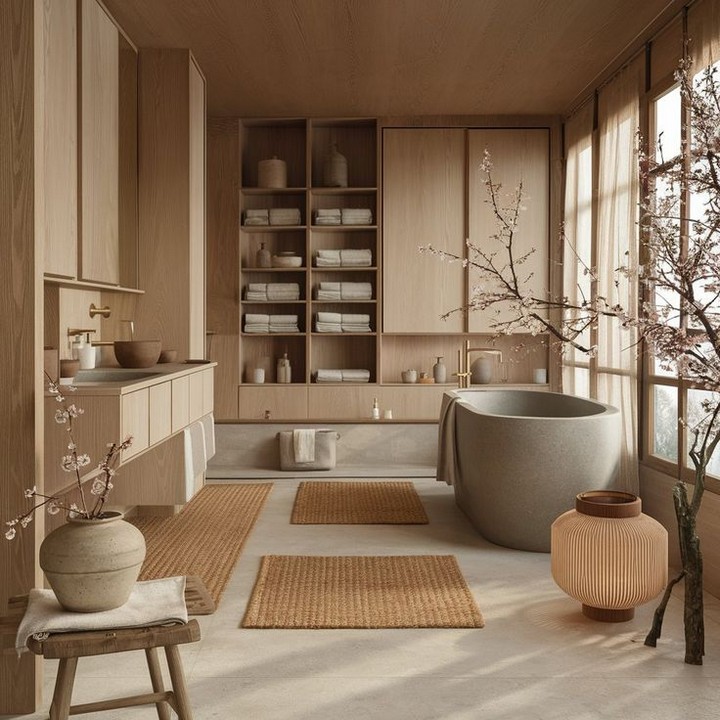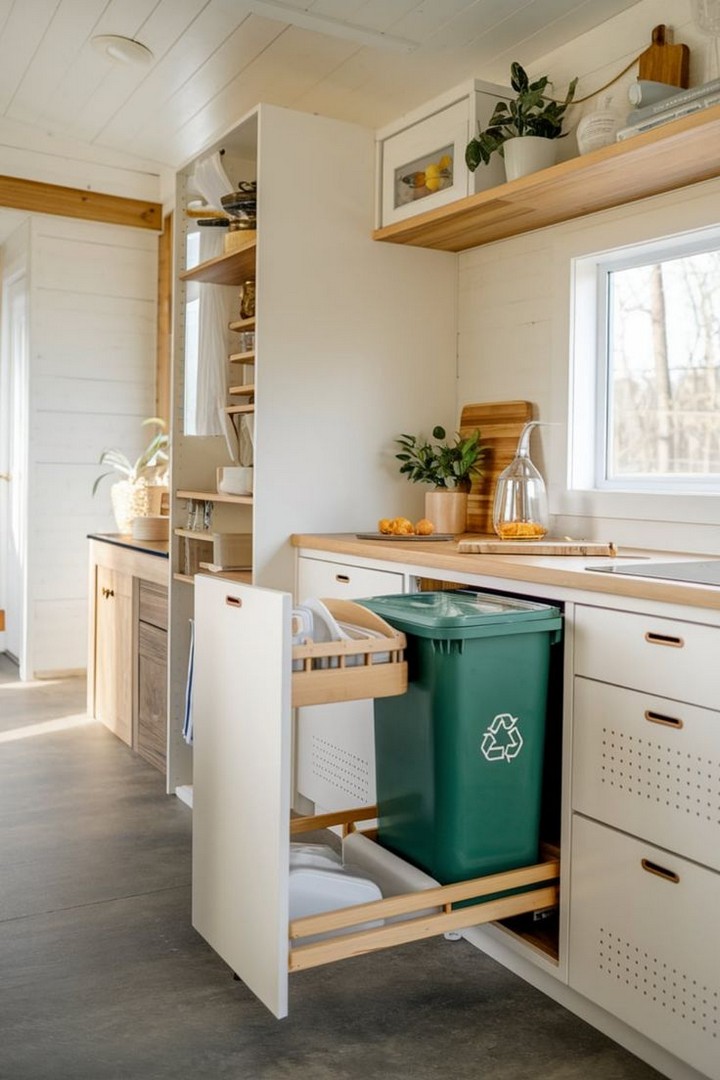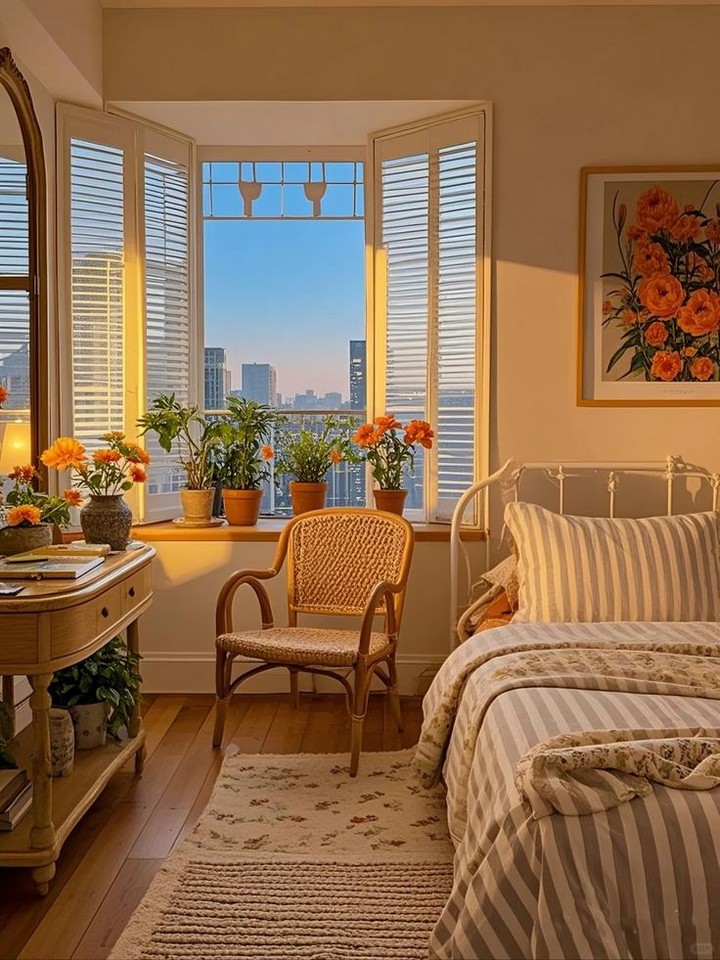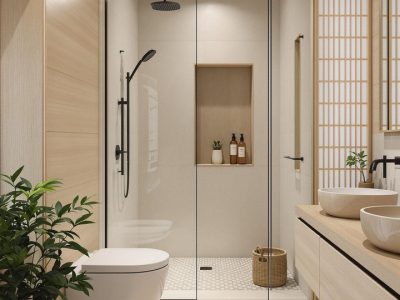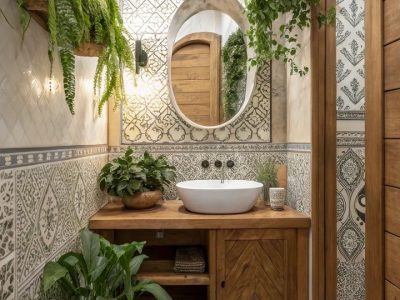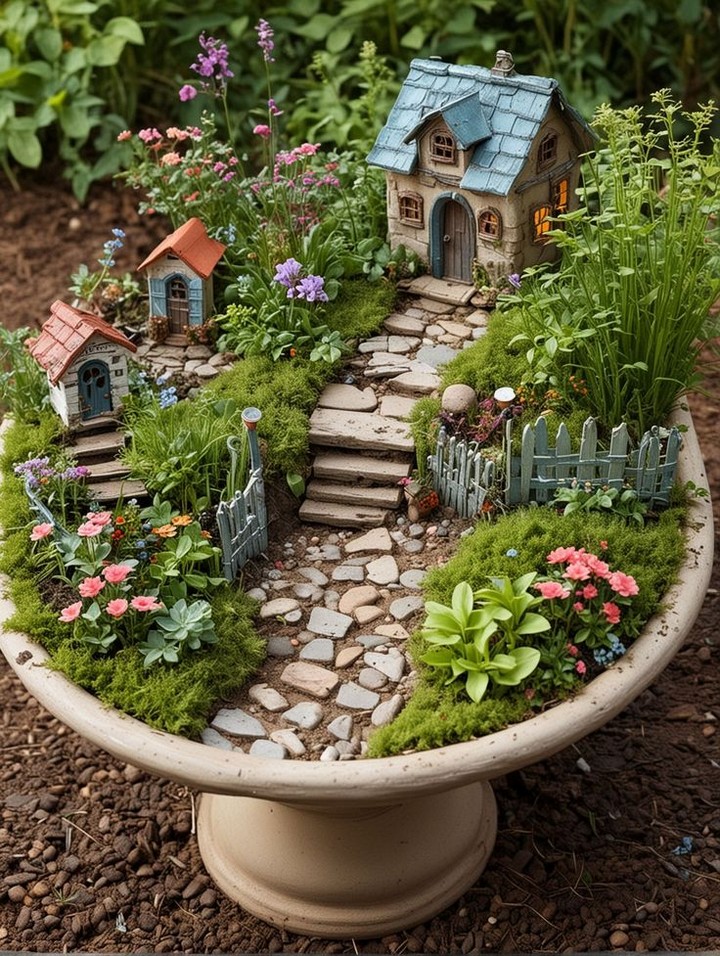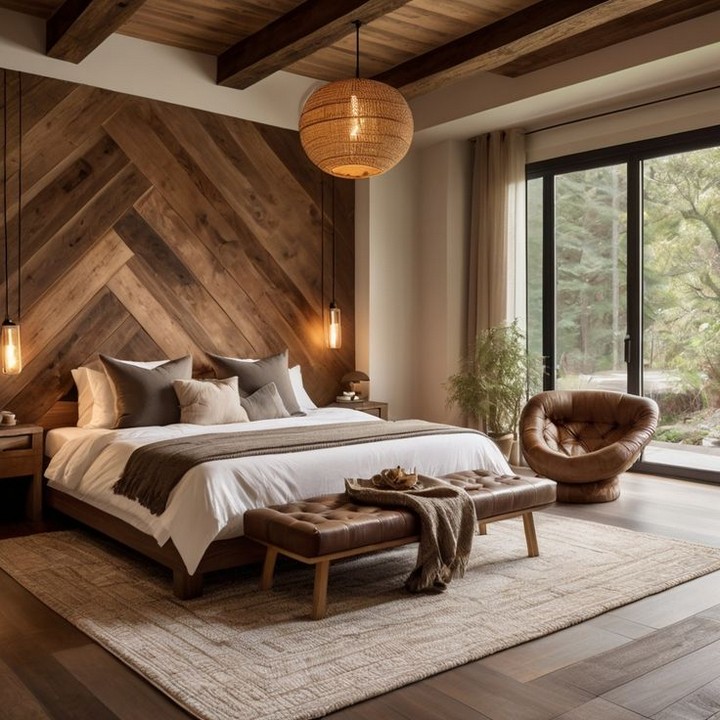This harmonious fusion of Japanese minimalism and Scandinavian functionality creates spaces that are both aesthetically pleasing and deeply practical. Nowhere does this design philosophy shine more brilliantly than in the bathroom a space where tranquility and functionality are equally essential.
Japandi style bathrooms exemplify the perfect balance between the clean lines and natural elements of Japanese design with the warm, cozy practicality of Scandinavian aesthetics. The result? Serene, unclutted bathroom spaces that feel both contemporary and timeless, minimal yet inviting.
This comprehensive guide explores 50 inspiring Japandi bathroom ideas that will help you transform your bathroom into a peaceful sanctuary. Whether you’re planning a complete renovation or simply looking to incorporate elements of this elegant design philosophy, these ideas offer practical inspiration for creating your own Japandi-inspired retreat.
Harmony of Japanese and Scandinavian Design
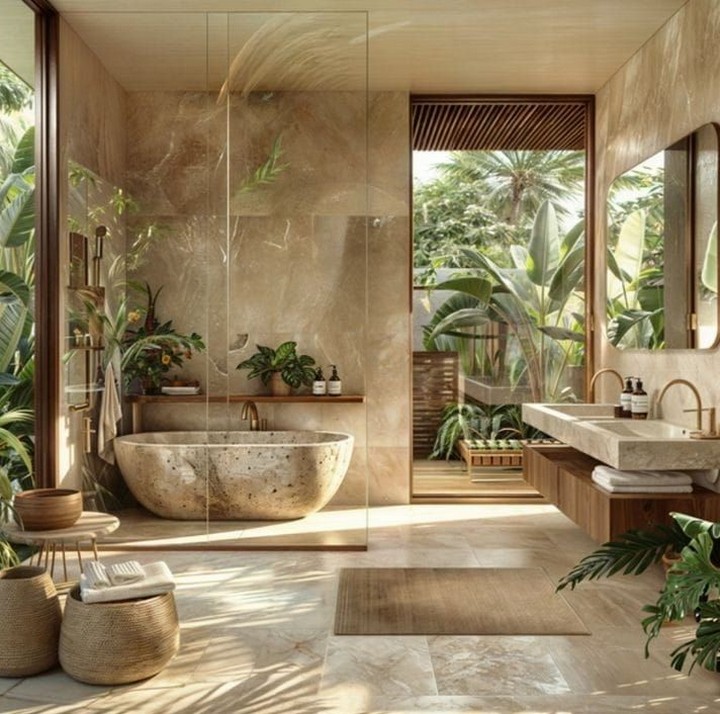
Japandi marries two distinct design traditions that share surprising similarities:
- Japanese Minimalism: Focuses on simplicity, natural materials, and intentional negative space (ma)
- Scandinavian Functionality: Emphasizes practicality, comfort, and natural light
Both traditions value craftsmanship, quality materials, and a connection to nature—making them perfect companions in bathroom design.
Natural Material Selections
1. Hinoki Wood Soaking Tub
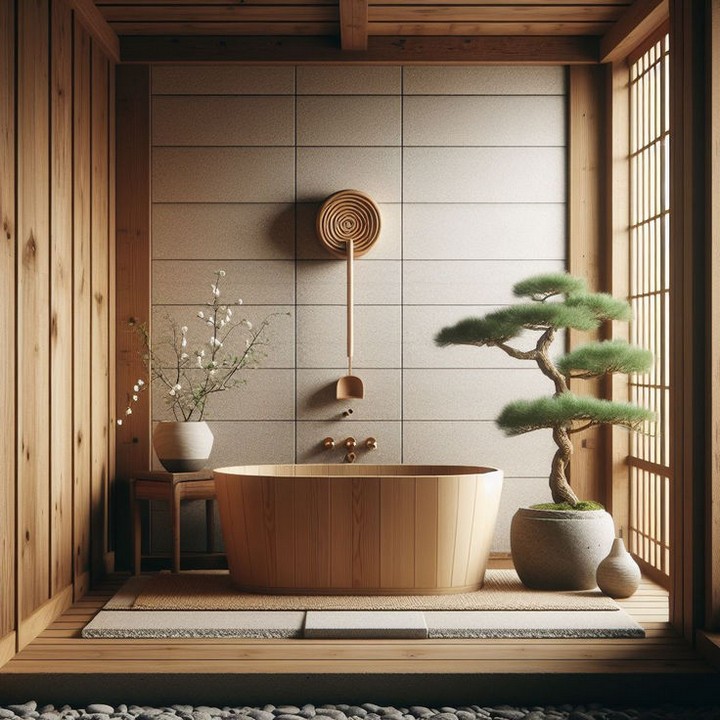
The ultimate Japandi bathroom luxury, a hinoki (Japanese cypress) wood soaking tub brings traditional Japanese bathing culture into your home. These deep, compact tubs embody the Japanese practice of ofuro meditative soaking while their warm wood tones add Scandinavian coziness. Modern versions include water-resistant treatments that maintain the natural beauty of the wood while ensuring longevity.
2. Teak Shower Floor Insert

Transform your shower experience with a teak wood floor insert. This simple addition brings warmth and natural texture to an otherwise cold surface while providing slip-resistant functionality. The natural oils in teak make it particularly suitable for wet environments, requiring minimal maintenance while aging beautifully over time.
3. Black Limestone Countertops
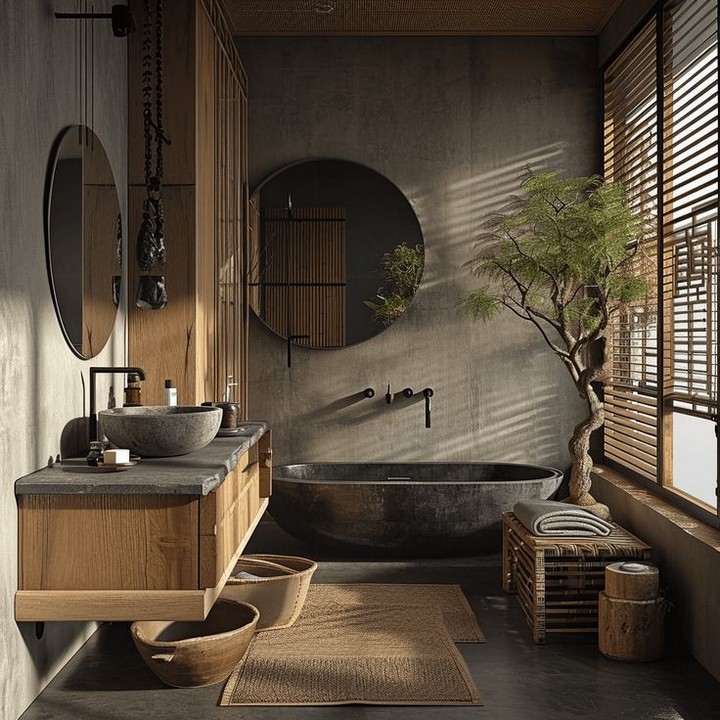
For a sophisticated Japandi look, consider black limestone countertops that provide dramatic contrast against lighter elements. This natural stone offers subtle texture variations rather than the high-polish uniformity of manufactured surfaces, creating interest while maintaining minimalist appeal.
4. Bamboo Bathroom Accessories
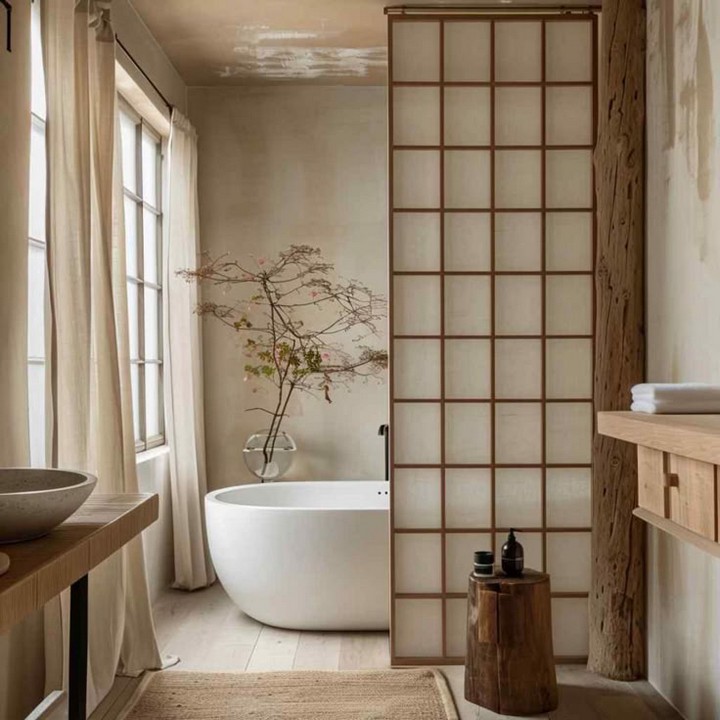
Incorporate sustainable bamboo accessories for small touches of Japandi style. Look for minimalist soap dispensers, toothbrush holders, and trays in natural or charcoal-stained bamboo. These elements add warmth while reinforcing the commitment to natural materials essential to Japandi design.
5. Cedar Bath Stool
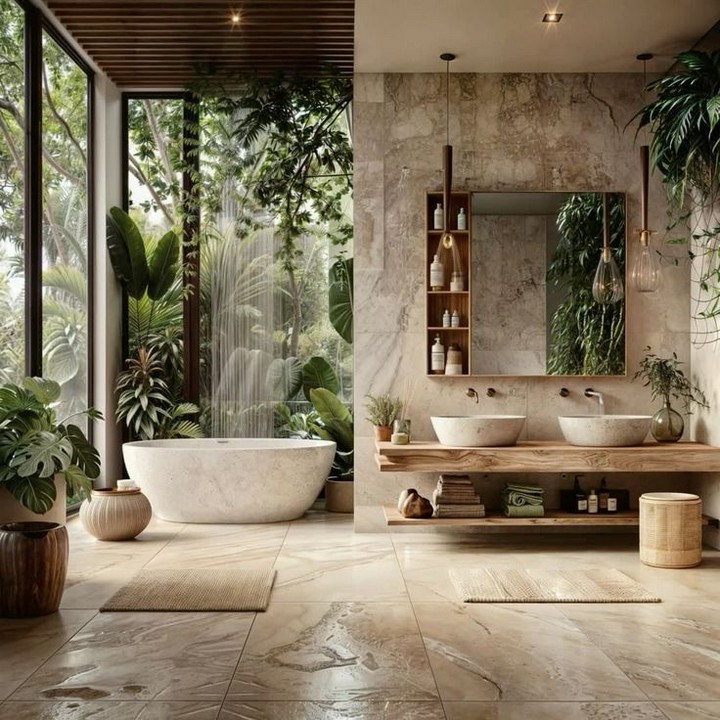
A simple cedar stool or bench serves multiple functions in a Japandi bathroom providing seating, serving as a platform for bath products, or acting as a design element when not in use. Choose pieces with minimal joinery and natural finishes that highlight the wood grain.
6. Paper Lantern Lighting
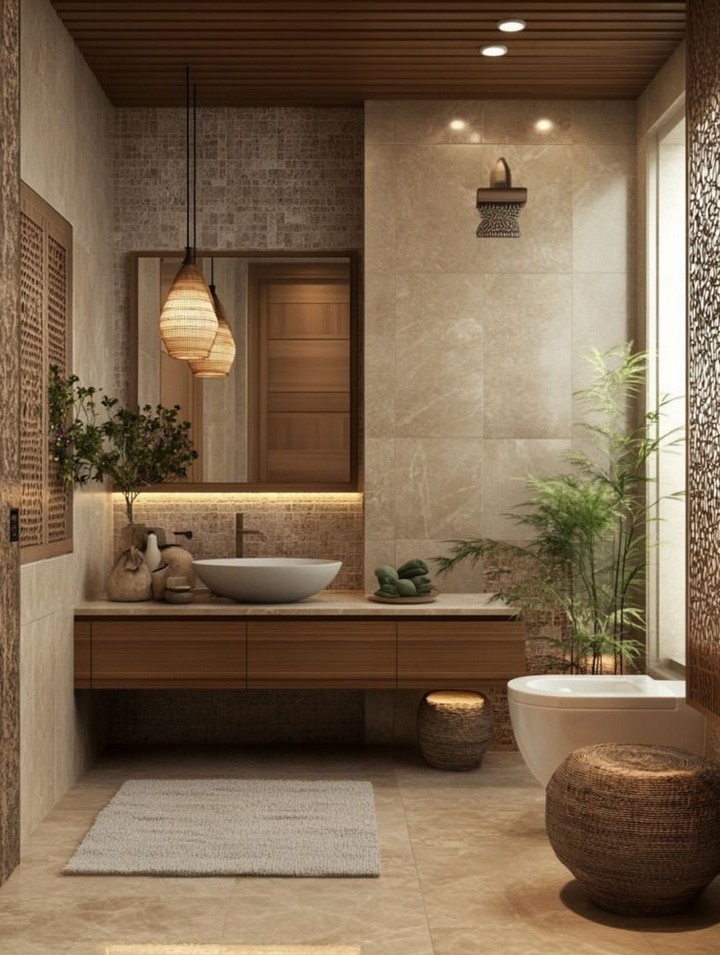
Incorporate the soft glow of paper lantern-inspired lighting fixtures for authentic Japanese ambiance combined with the Scandinavian emphasis on warm, diffused light. Modern versions with waterproof materials and LED technology make these practical for bathroom environments.
7. Unpolished Stone Vessel Sink
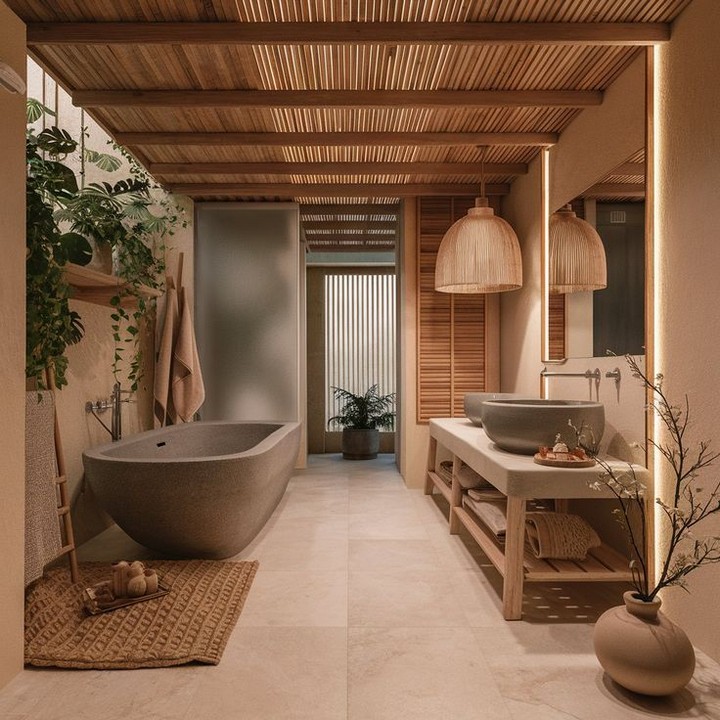
Replace conventional bathroom sinks with vessel-style basins in unpolished stone. These statement pieces embody wabi-sabi—the Japanese appreciation for imperfection—while their natural variation adds visual interest to minimalist surroundings.
8. Rattan Storage Elements

Introduce texture with rattan storage baskets or hampers. This natural fiber brings warmth and tactile interest while providing practical storage solutions that keep the space organized and clutter-free.
9. Marble with Visible Veining
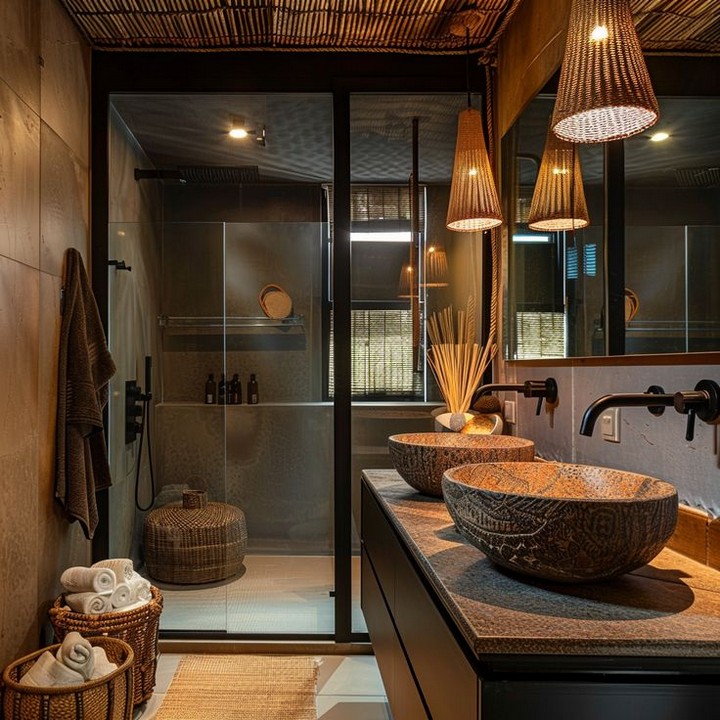
When incorporating marble, choose varieties with distinct, natural veining rather than uniform patterns. This celebrates the natural characteristics of the stone while creating subtle visual movement in keeping with Japandi’s appreciation for nature’s imperfections.
10. Wood-Frame Mirrors
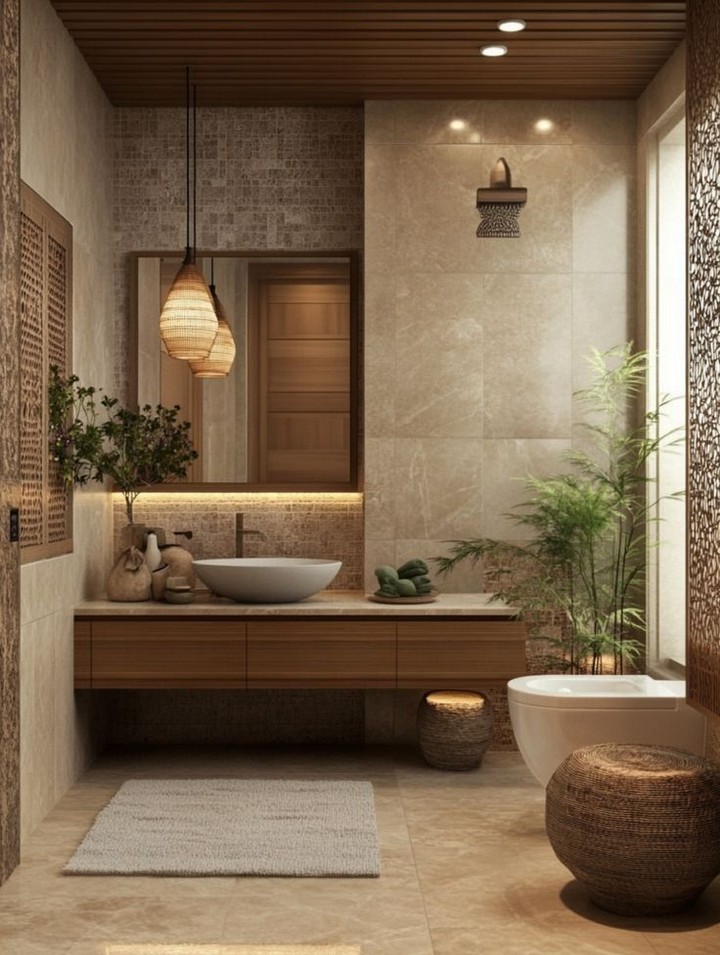
Replace ornate bathroom mirrors with simple wood-framed designs. Select frames with minimal profiles in natural oak, walnut, or ash to complement other wooden elements in your Japandi bathroom.
Color Palette and Finishes
11. Charcoal and Natural Linen Contrast
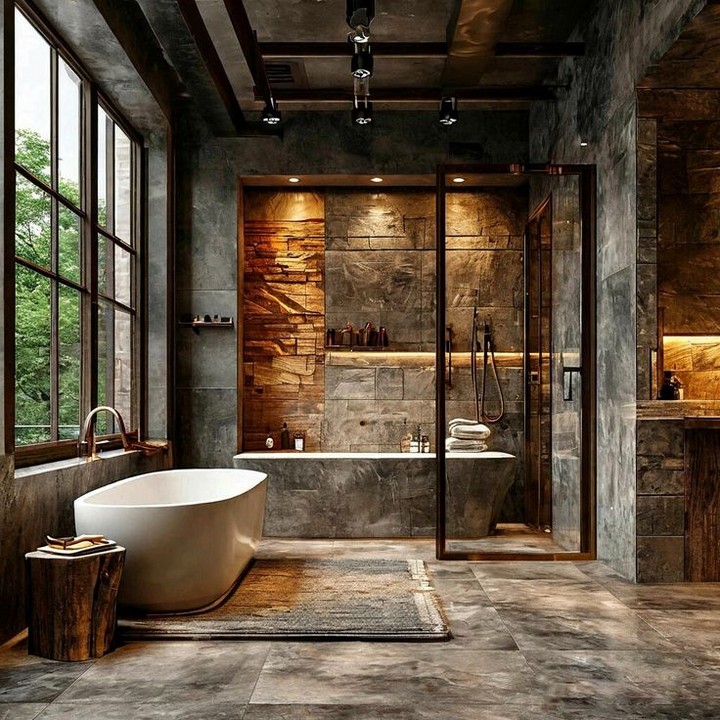
Create depth with a palette that juxtaposes charcoal gray elements against natural linen tones. This balanced contrast embodies the Japandi approach to color—subtle variation rather than stark opposition.
12. Clay-Toned Wall Finishes

Move beyond basic white with clay-inspired neutral wall finishes. These warm, earthy tones reference traditional Japanese plastering techniques while creating a cozy atmosphere typical of Scandinavian interiors.
13. Black Matte Fixtures

Replace shiny chrome fixtures with black matte alternatives for faucets, shower heads, and hardware. These understated elements recede visually, allowing natural materials to take center stage while adding contemporary sophistication.
14. Whitewashed Wood Panels
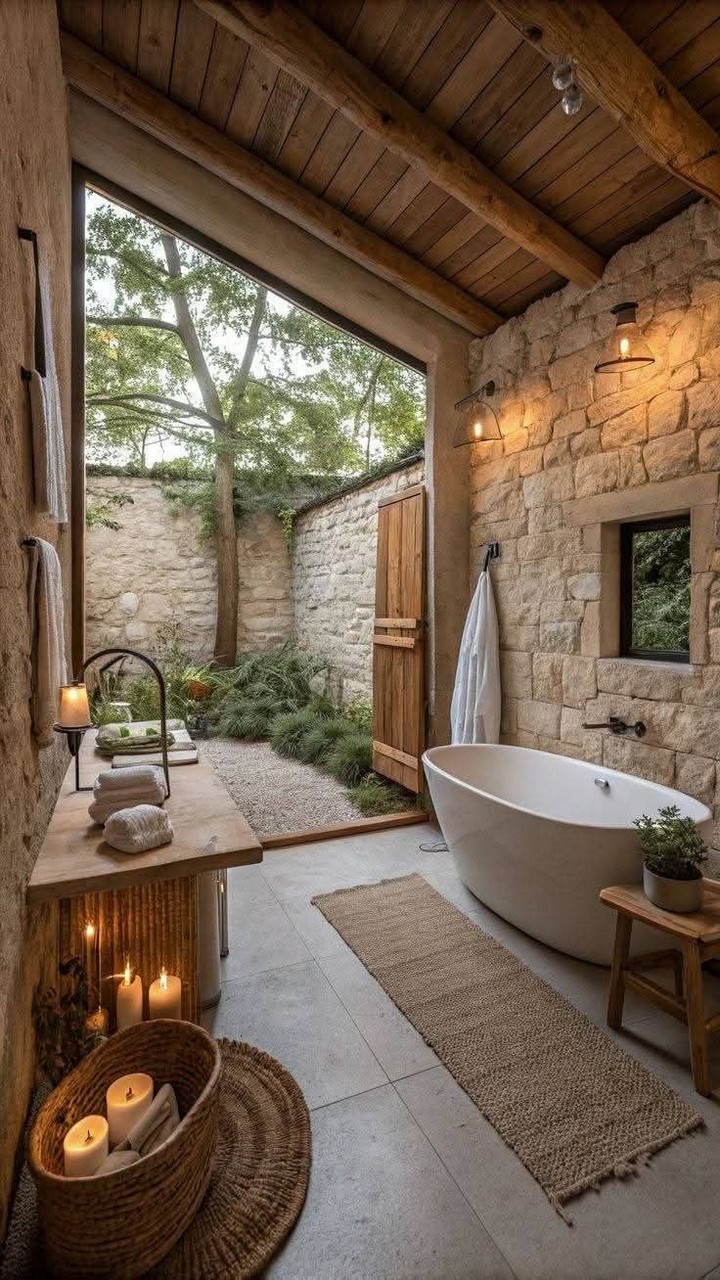
For wall treatments with subtle texture, consider whitewashed wood panels. This technique preserves the natural grain pattern while lightening the overall effect—perfect for smaller bathrooms that benefit from lighter surfaces.
15. Concrete Shower Walls
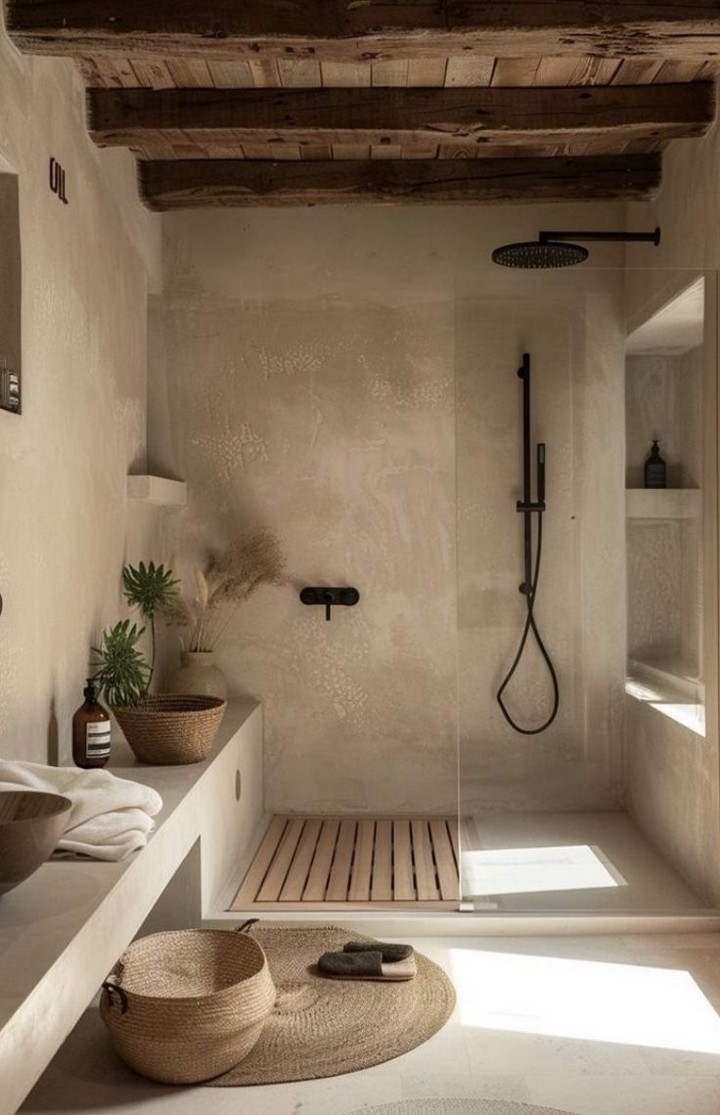
Embrace concrete for shower surrounds or accent walls. This material offers minimalist appeal with subtle tonal variations and pairs beautifully with wood elements for classic Japandi contrast.
16. Indigo Textile Accents
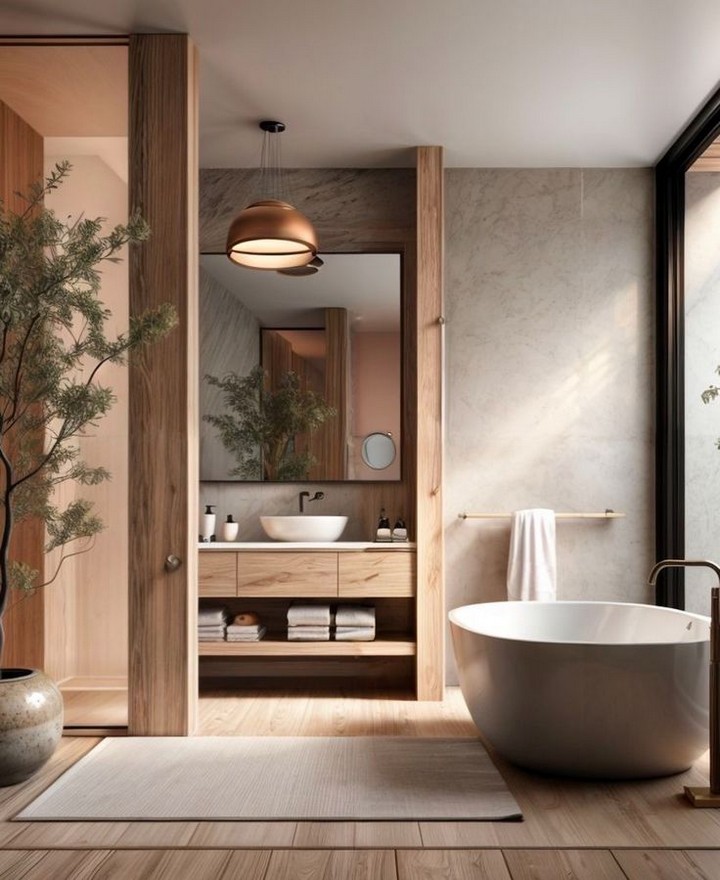
Incorporate the Japanese tradition of indigo dyeing through simple textile accents. Hand towels, bath mats, or shower curtains in indigo tones add depth to the neutral Japandi palette while referencing traditional craft techniques.
17. Green-Gray Undertones
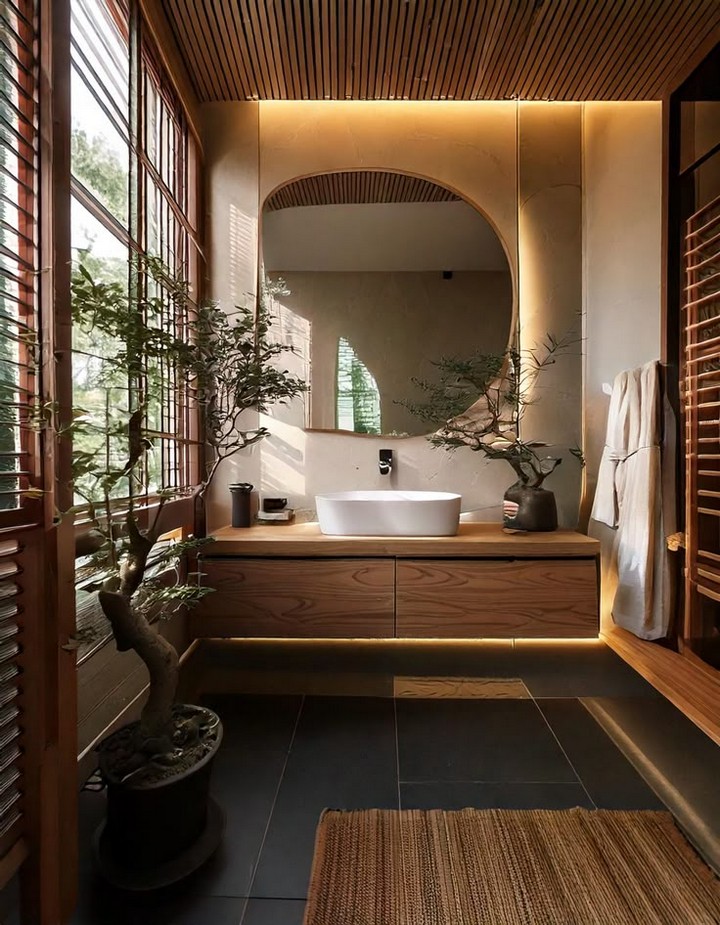
Select paint colors with subtle green-gray undertones that reference the natural environments that inspire both Japanese and Scandinavian design traditions. These complex neutrals change subtly with lighting conditions, adding dimension to simple spaces.
18. Terracotta Floor Tiles

Ground your Japandi bathroom with terracotta floor tiles in matte finishes. These elements bring warmth through both color and texture while providing practical, slip-resistant surfaces for wet areas.
19. Smoked Glass Partitions
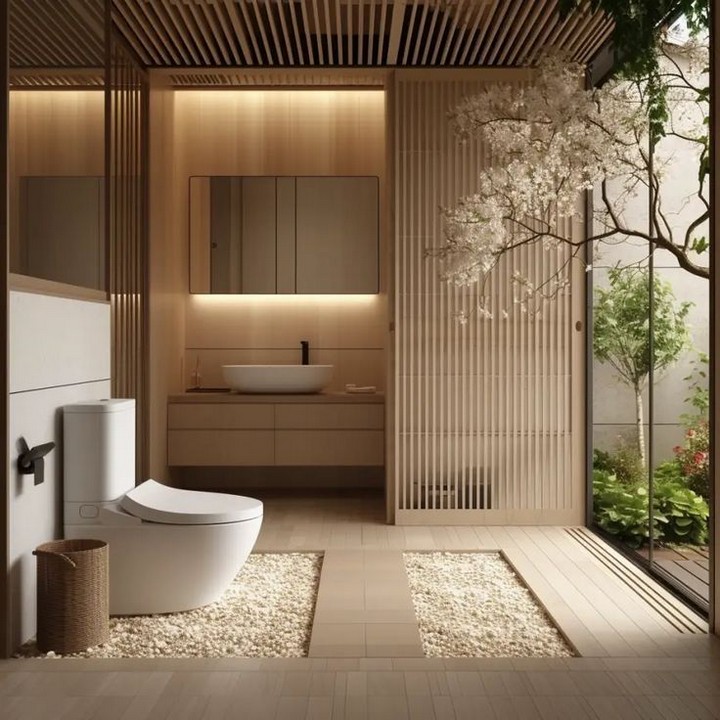
Define shower areas with smoked glass partitions that provide privacy without visual heaviness. These translucent elements allow light transmission while adding subtle smokiness that complements the Japandi color palette.
20. Natural Fiber Wallcoverings
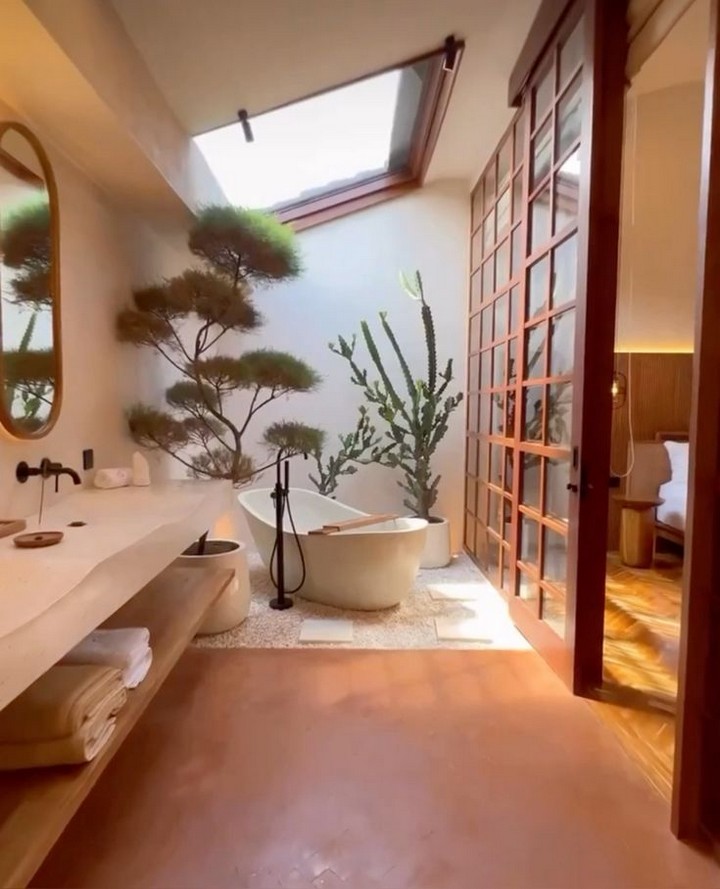
For textural interest, consider natural fiber wallcoverings like grasscloth or sisal in bathroom areas away from direct water exposure. These materials add subtle pattern through their inherent texture while maintaining the natural material focus central to Japandi design.
Functional Layout Solutions
21. Wet Room Configuration
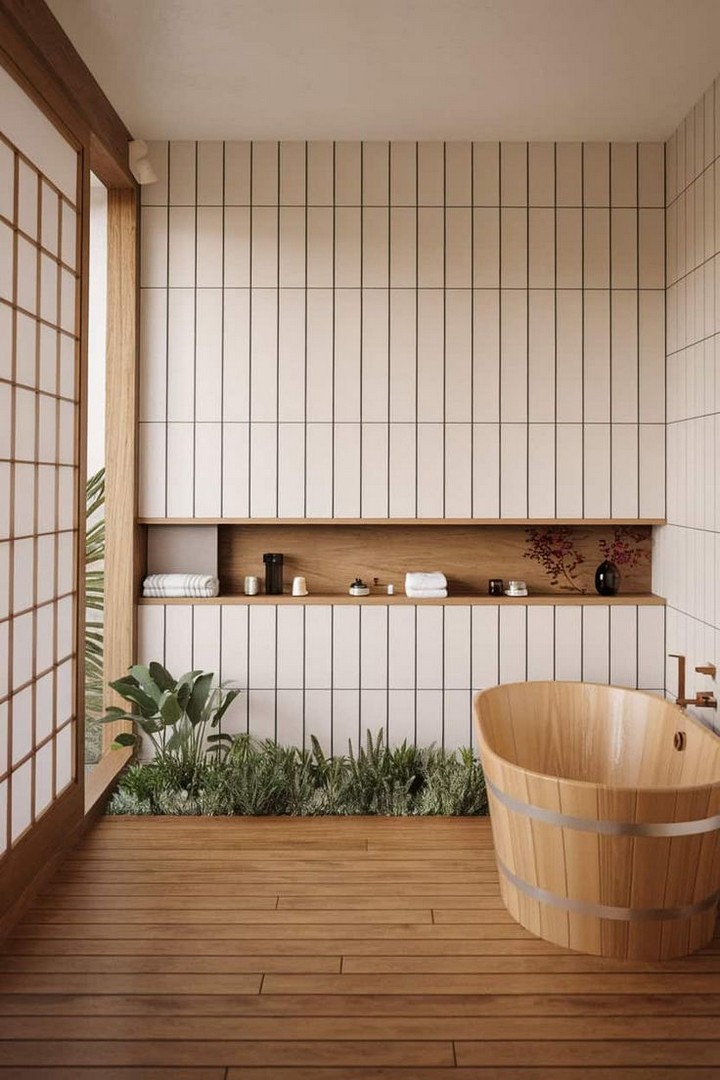
Embrace the Japanese approach to bathing with a wet room layout that integrates shower and soaking tub in a single waterproof space. This efficient arrangement maximizes floor area in smaller bathrooms while creating a spa-like experience.
22. Floating Vanities
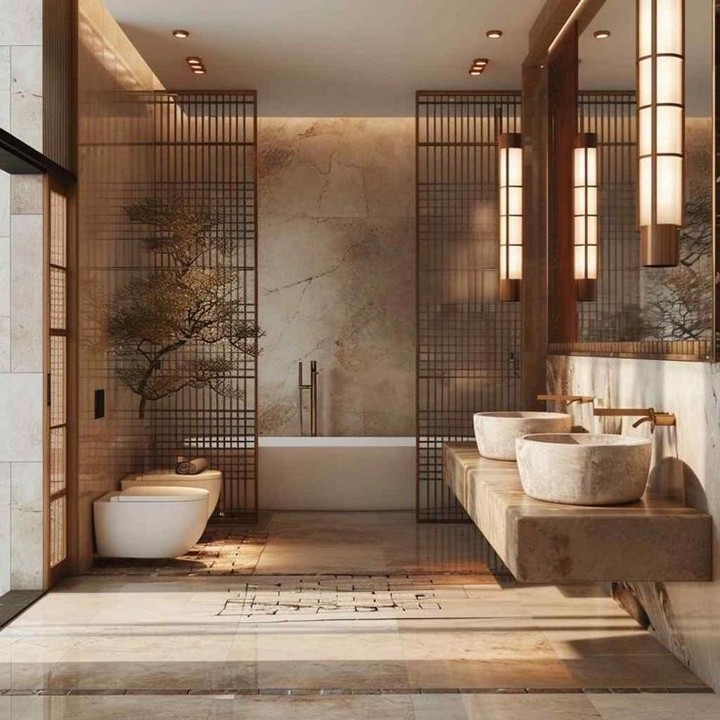
Create visual spaciousness with wall-mounted floating vanities that expose floor area beneath. This design choice makes small bathrooms appear larger while facilitating easier cleaning embodying both Japanese minimalism and Scandinavian practicality.
23. Integrated Storage Niches

Reduce visual clutter with recessed storage niches in shower walls or beside vanities. These practical elements maintain clean lines while providing accessible storage for bath products without protruding into the space.
24. Half-Wall Room Dividers
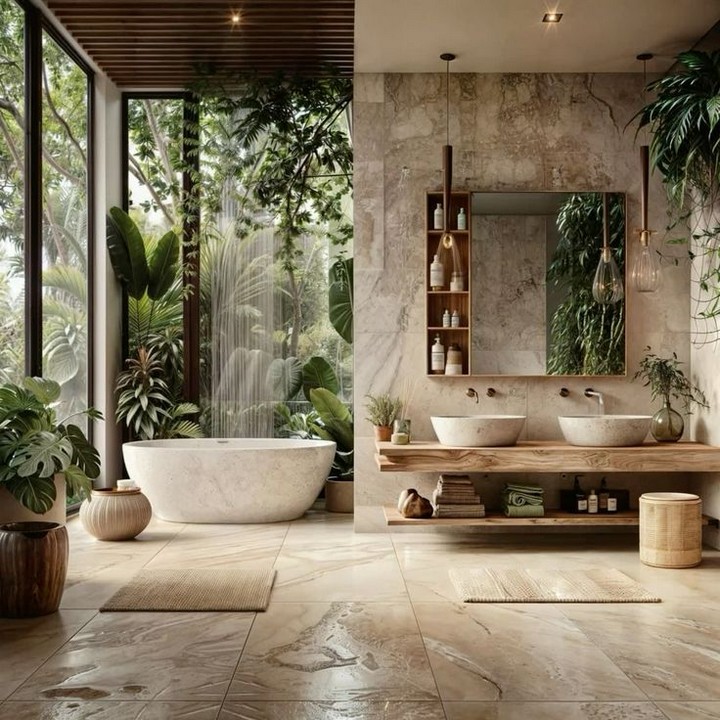
Define bathroom zones without sacrificing openness using half-height walls. These architectural elements can separate toilet areas from bathing spaces or support vanity countertops while maintaining visual connection throughout the room.
25. Linear Floor Drains
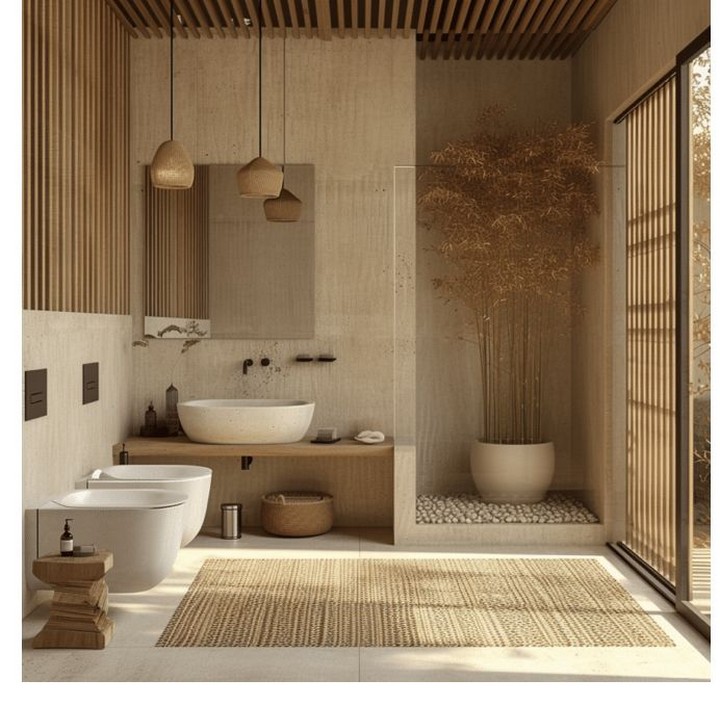
Replace conventional center drains with sleek linear models that allow for continuous tile patterns. This subtle detail supports the Japandi emphasis on uninterrupted lines and thoughtful functionality.
26. Open Shelf Under-Sink Storage
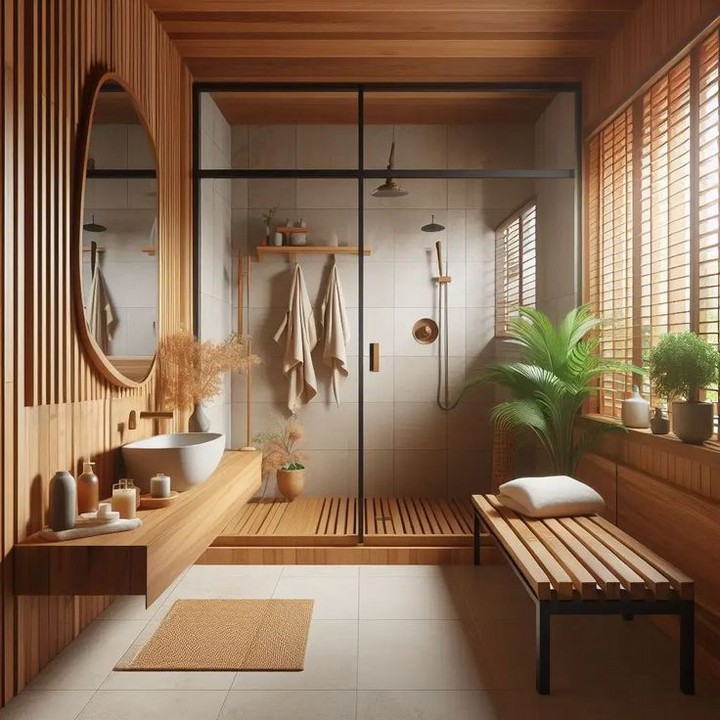
Rather than enclosed vanity cabinets, consider open shelving beneath vessel sinks. This approach references traditional Japanese bathroom design while keeping necessities visible and accessible though it requires disciplined organization to maintain the minimalist aesthetic.
27. Corner Soaking Tubs
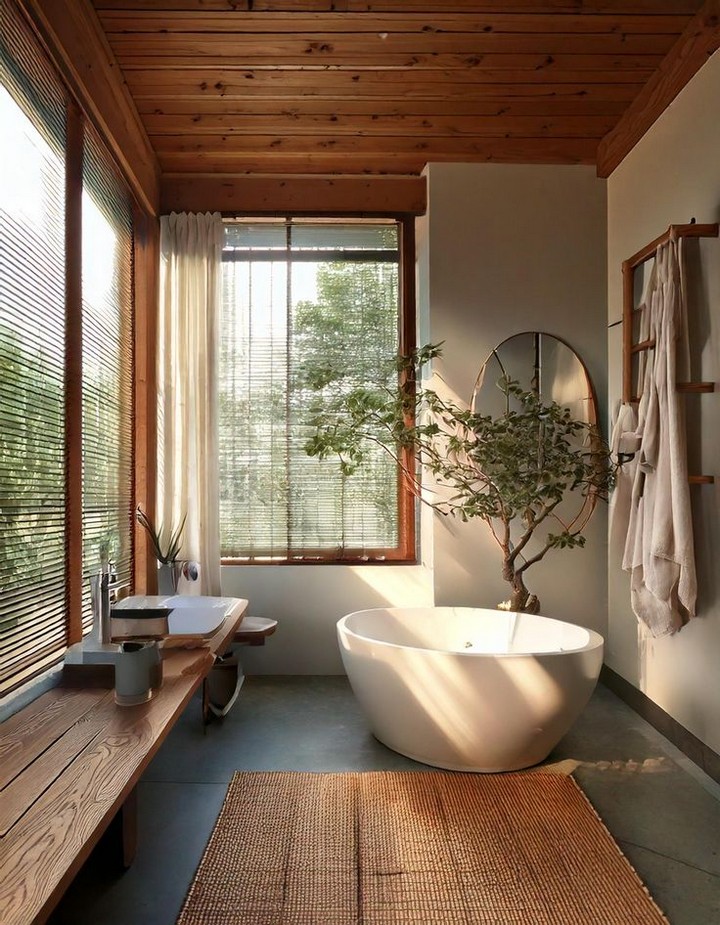
Maximize space efficiency with corner-positioned soaking tubs. These space-saving solutions work well in smaller bathrooms while creating architectural interest through geometric contrast with predominantly rectilinear elements.
28. Integrated Bench Seating
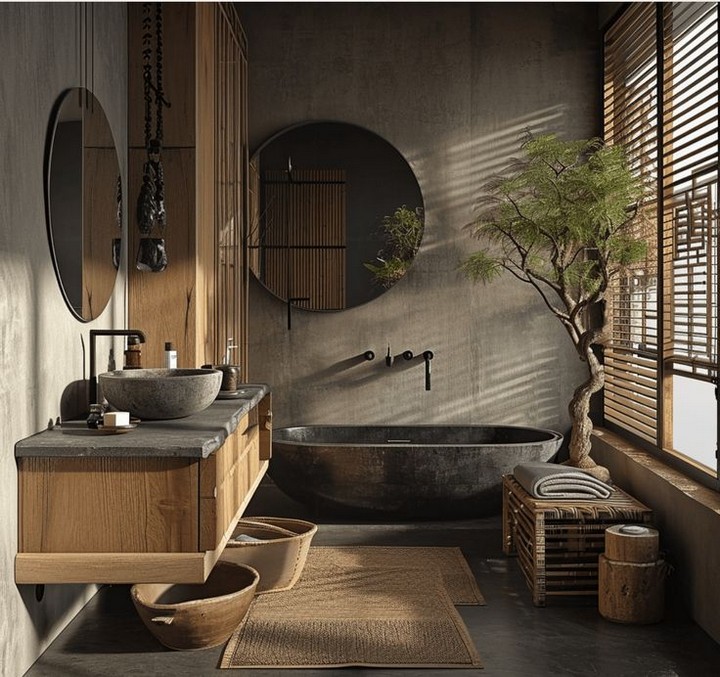
Incorporate practical seating through built-in shower benches or tub surrounds. These functional elements provide convenience while maintaining the clean lines and continuous surfaces characteristic of Japandi design.
29. Sliding Door Systems
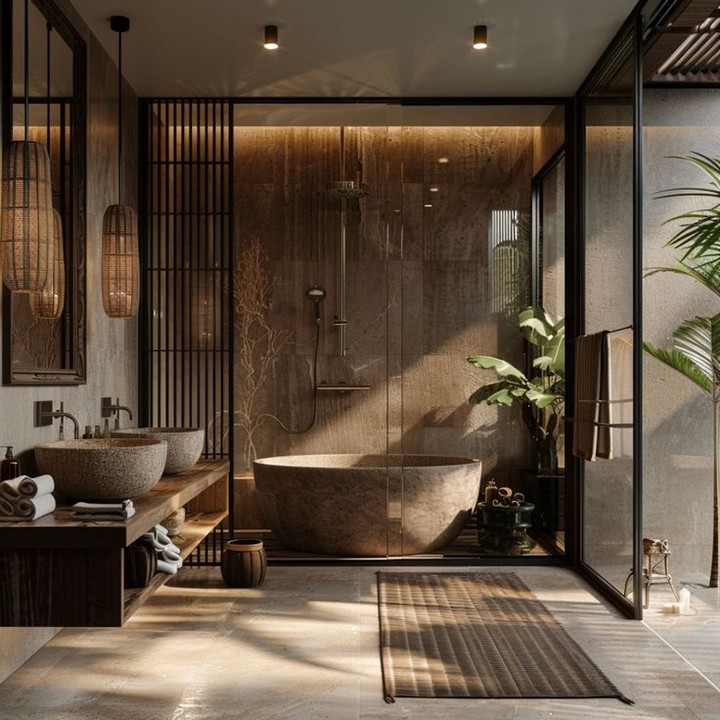
Embrace the Japanese tradition of sliding doors (fusuma) with modern bathroom applications. These space-efficient room dividers or cabinet closures operate without requiring swing space, making them ideal for compact bathrooms.
30. Elevated Platform Areas
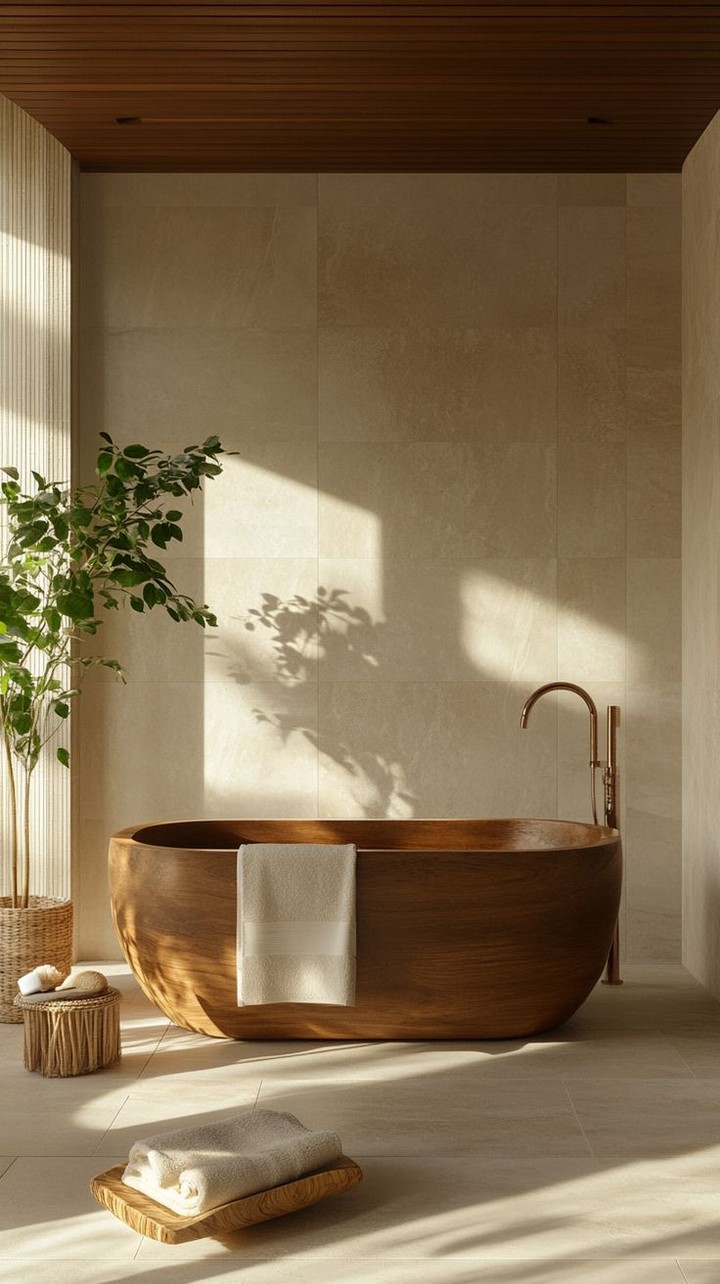
Reference traditional Japanese architectural elements by creating slightly elevated platform areas for soaking tubs or shower zones. These subtle level changes define functional areas while adding architectural interest without visual busyness.
Lighting Approaches
31. Integrated Linear Lighting
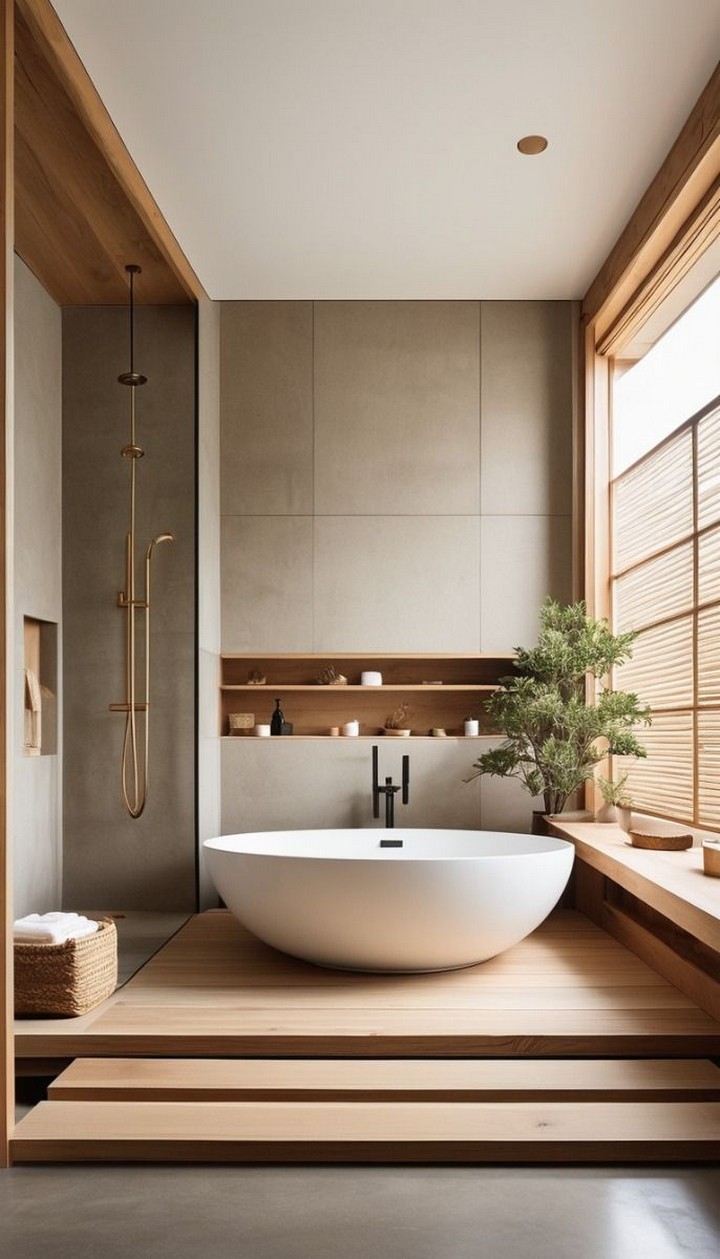
Incorporate subtle lighting through recessed linear fixtures that emphasize architectural elements rather than calling attention to the light source itself. This indirect approach creates atmospheric illumination that enhances the serene quality of Japandi spaces.
32. Natural Light Maximization
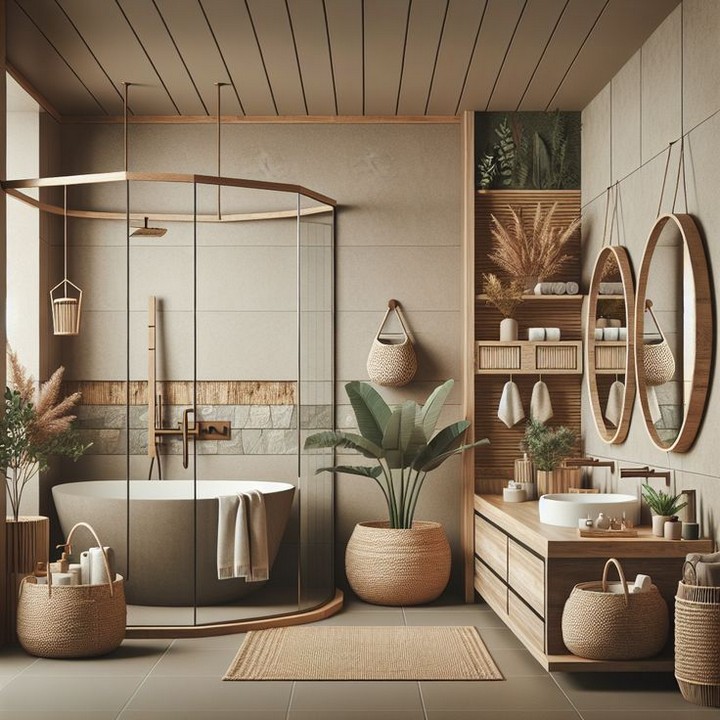
Prioritize natural light through strategically placed windows, perhaps with frosted glass for privacy. Consider skylights or clerestory windows that flood the space with gentle illumination from above, reducing dependence on artificial lighting during daylight hours.
33. Pendant Lanterns
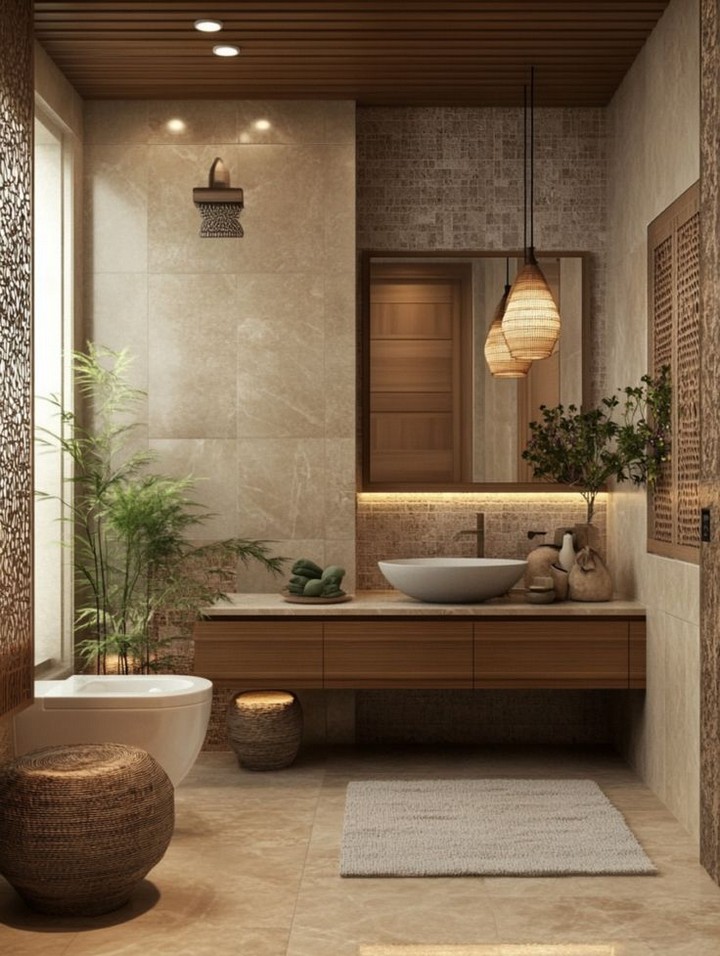
For areas requiring direct lighting, select simple pendant fixtures inspired by traditional Japanese lanterns but with clean Scandinavian lines. Choose paper, linen, or wood elements that diffuse light softly rather than creating harsh illumination.
34. Backlit Mirrors
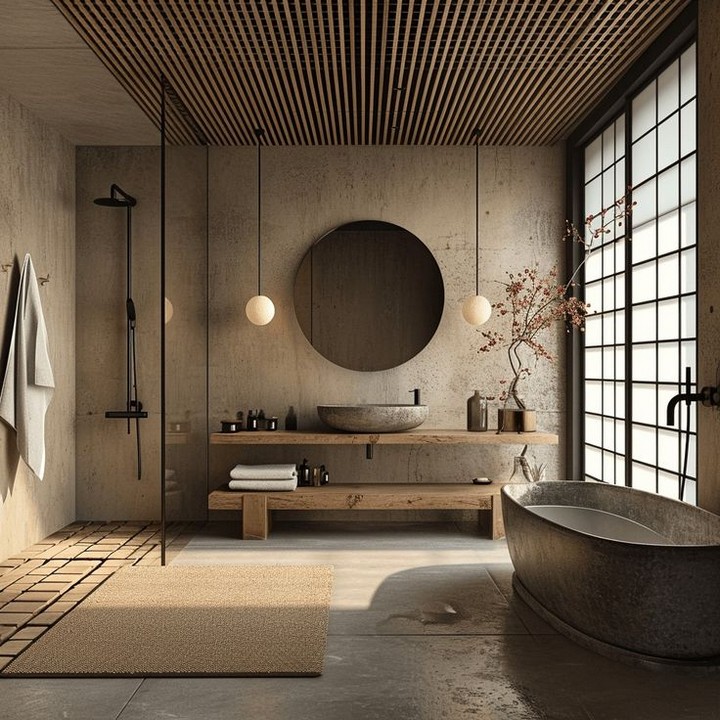
Combine functionality with atmosphere through mirrors with integrated backlighting. These practical elements provide even, shadow-free light for grooming tasks while contributing to the overall ambient lighting scheme.
35. Candle Arrangements
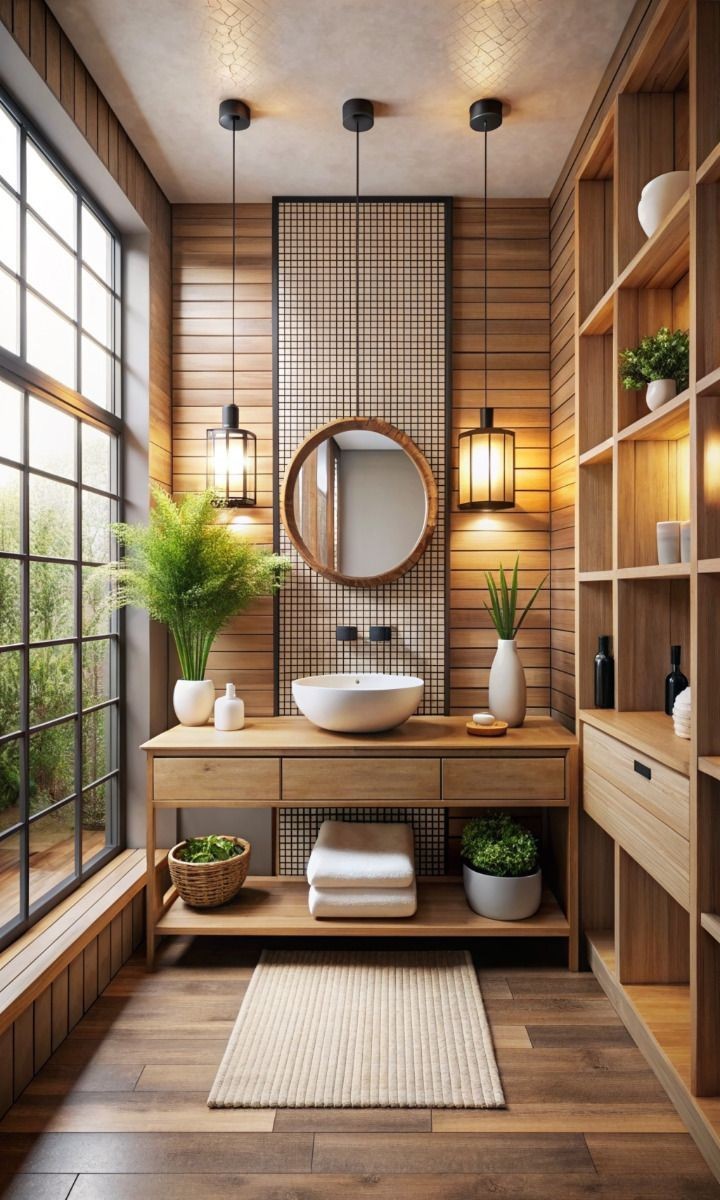
Embrace the Scandinavian tradition of candle lighting for creating atmosphere. Arrange simple candles on stone or wooden holders for moments of relaxation in the bath—functional decor that enhances the sensory experience of the space.
Storage and Organization
36. Bamboo Drawer Dividers
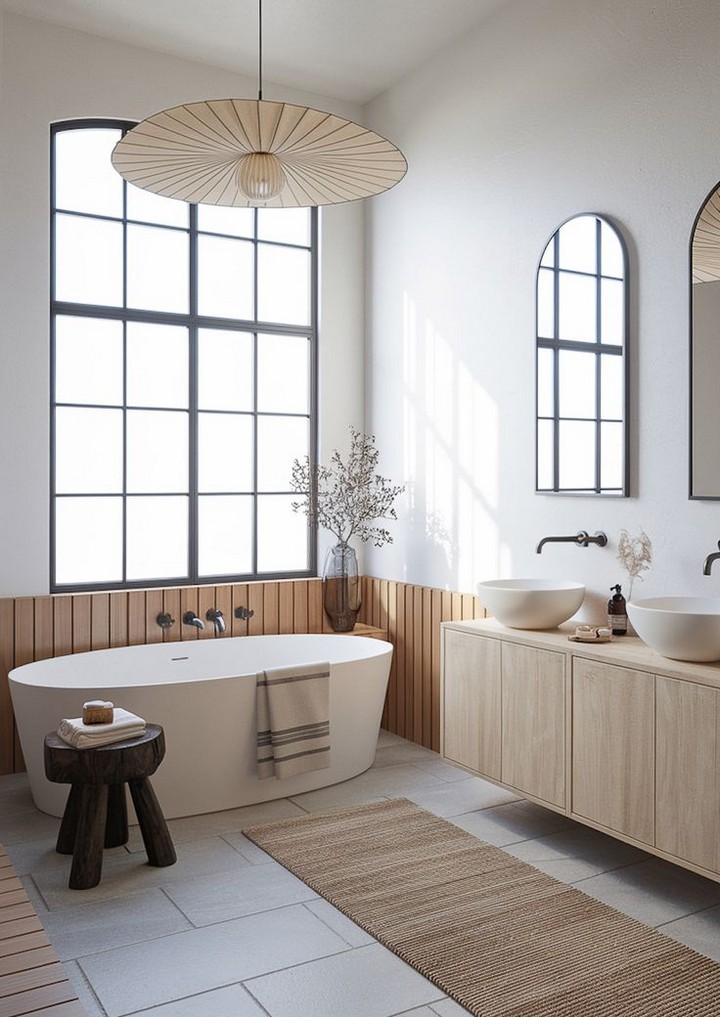
Maintain interior order with bamboo drawer dividers that compartmentalize storage spaces. These elements apply the Japandi principle of thoughtful organization to hidden spaces, ensuring that even unseen areas reflect the minimalist ethos.
37. Wall-Hung Storage Cabinets
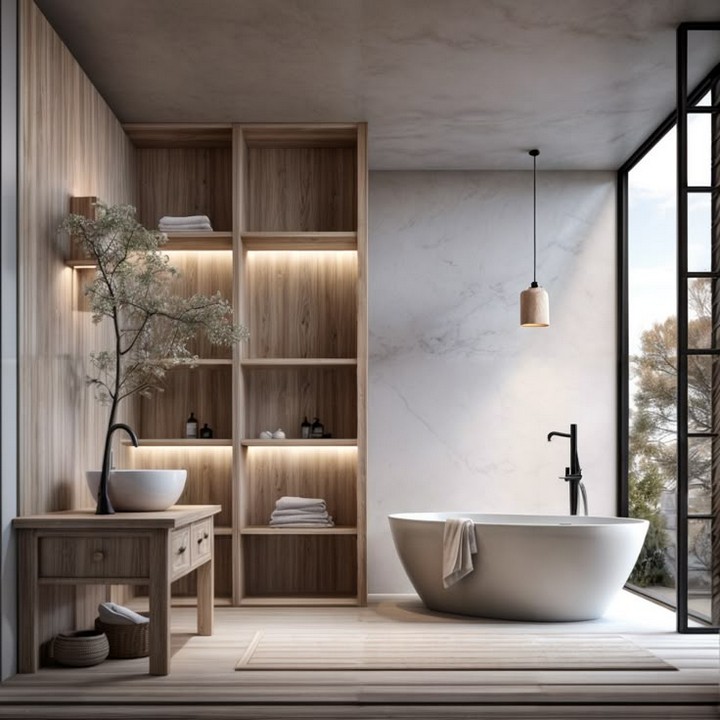
Save floor space with shallow wall-mounted cabinets that provide storage without visual heaviness. Choose simple door designs without hardware for the cleanest aesthetic, or incorporate natural wood fronts for warmth.
38. Bath Product Decanting
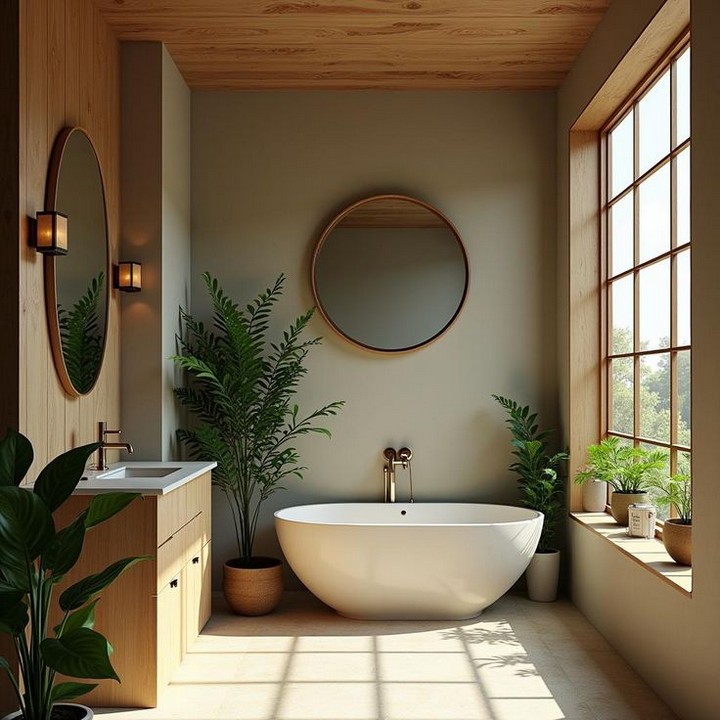
Transfer bath products into consistent, minimalist containers to reduce visual noise from commercial packaging. Select simple vessels in amber glass, matte ceramics, or wood-capped bottles that complement the overall design scheme.
39. Intentional Negative Space
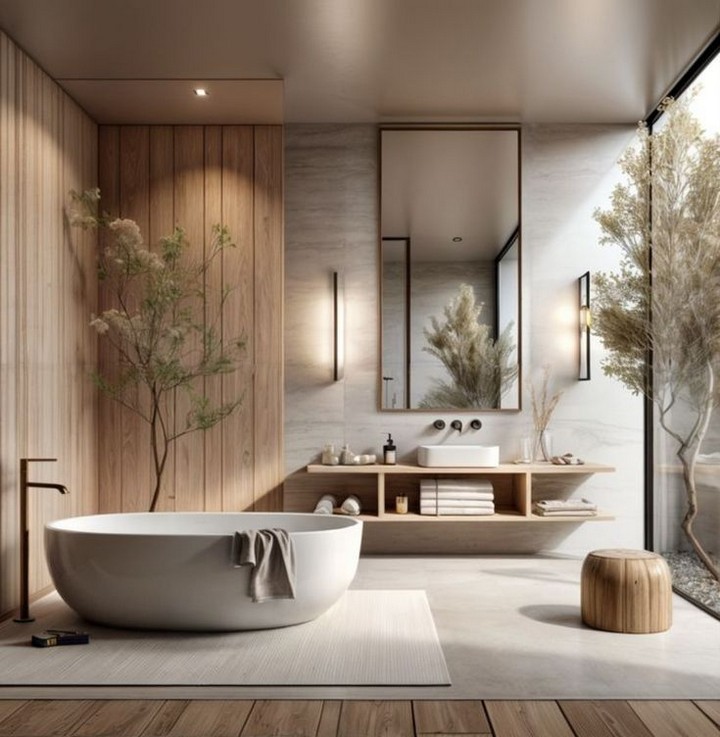
Apply the Japanese concept of ma (negative space) to storage planning by deliberately incorporating empty space. Resist the urge to fill every shelf completely—this restraint creates visual breathing room essential to the Japandi aesthetic.
40. Hidden Electrical Outlets
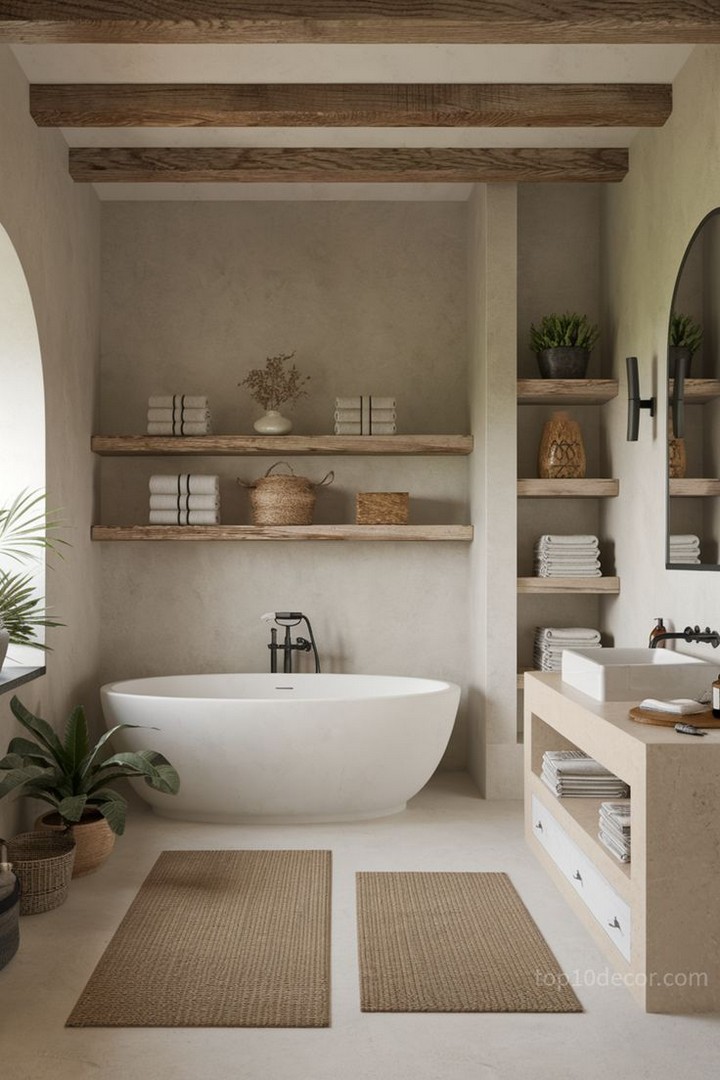
Maintain clean lines by concealing necessary electrical outlets within drawers or behind sliding panels. This approach keeps utilitarian elements from disrupting the visual serenity of the space while maintaining full functionality.
Decorative Elements
41. Single Branch Arrangements
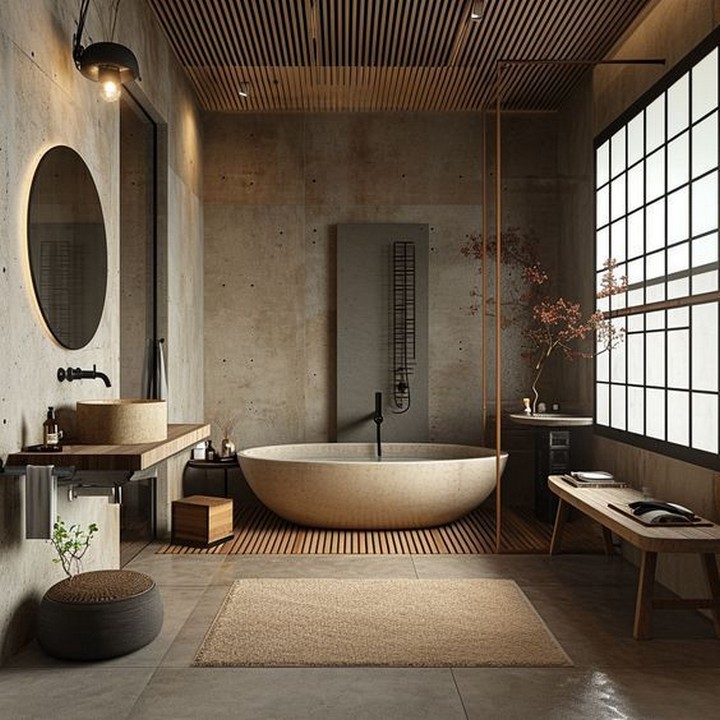
Replace elaborate floral displays with single branch arrangements that showcase natural form. A blooming cherry branch in spring or maple foliage in autumn brings seasonal awareness into the bathroom while adhering to minimalist principles.
42. Natural Stone Display
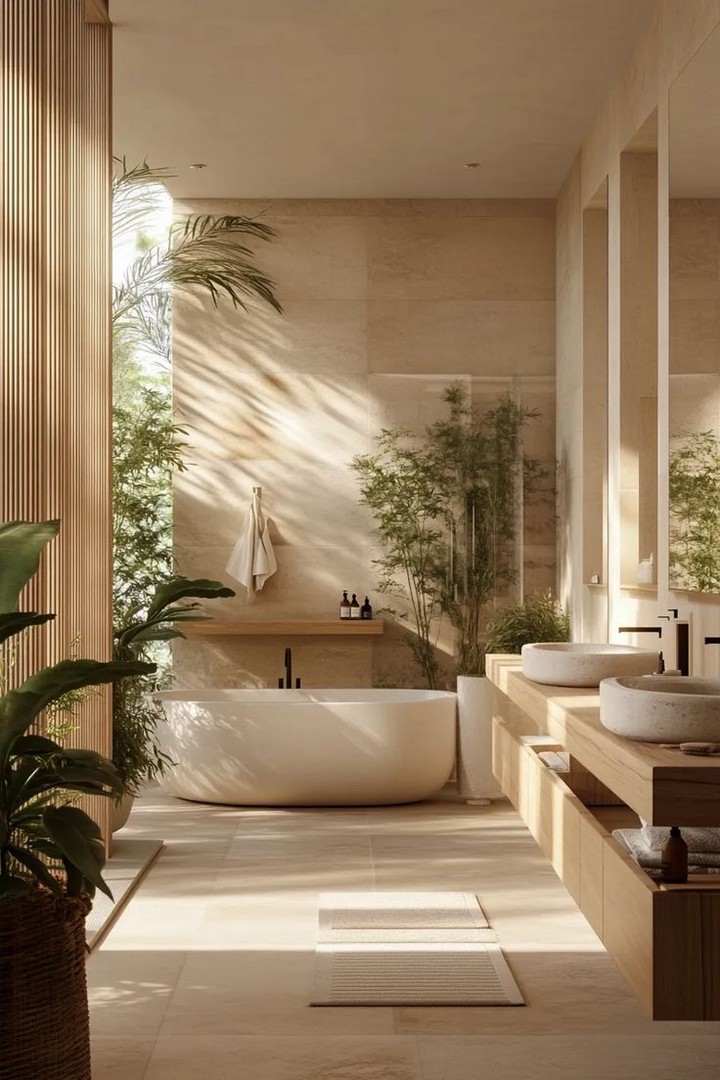
Incorporate the Japanese tradition of stone appreciation with a simple arrangement of river rocks or a single interesting stone specimen. These elements connect the space to nature while providing meditative focal points.
43. Minimalist Art Selection
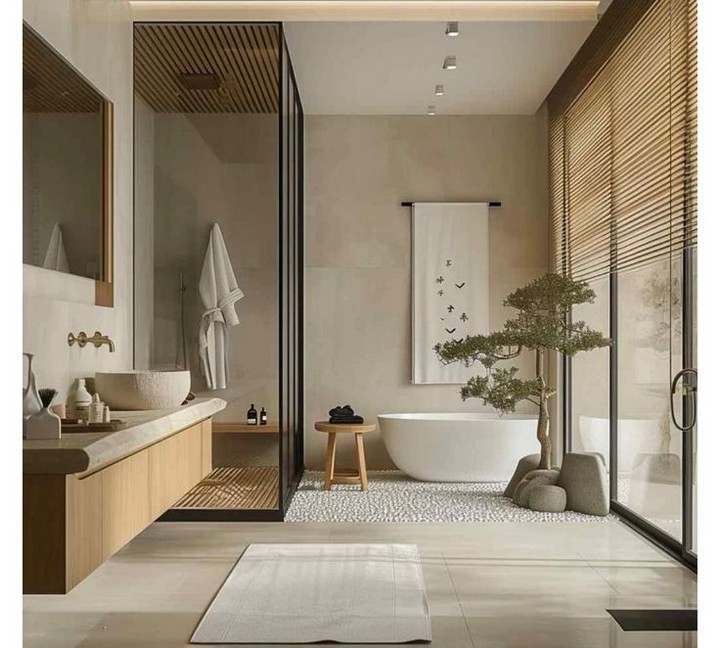
When including wall art, select a single impactful piece rather than multiple small elements. Consider monochromatic ink paintings, abstract nature photography, or simple line drawings that complement rather than compete with the serene environment.
44. Handcrafted Ceramic Pieces
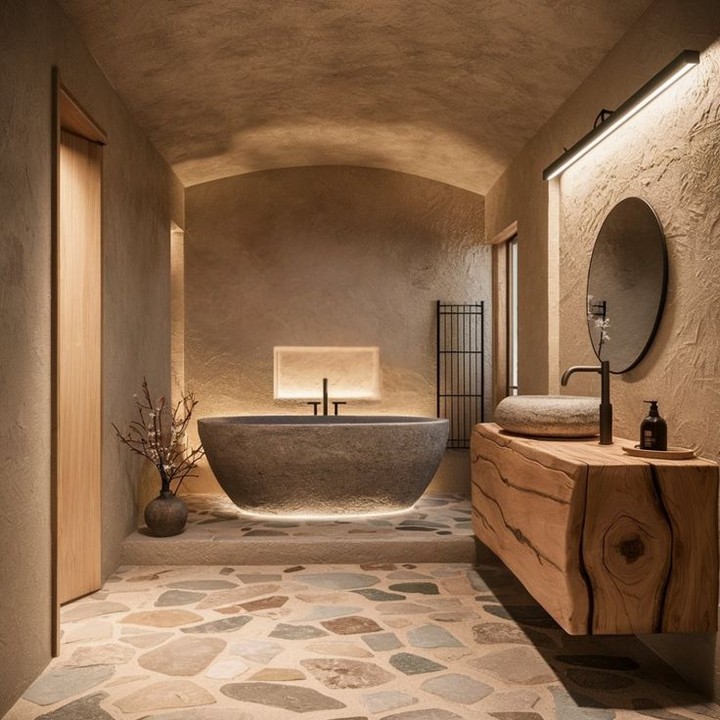
Honor the Japandi emphasis on craftsmanship through carefully selected ceramic pieces like a handmade soap dish or vase. Choose items with subtle glaze variations and evidence of the maker’s hand rather than machine-perfect production pieces.
45. Natural Sponges and Brushes
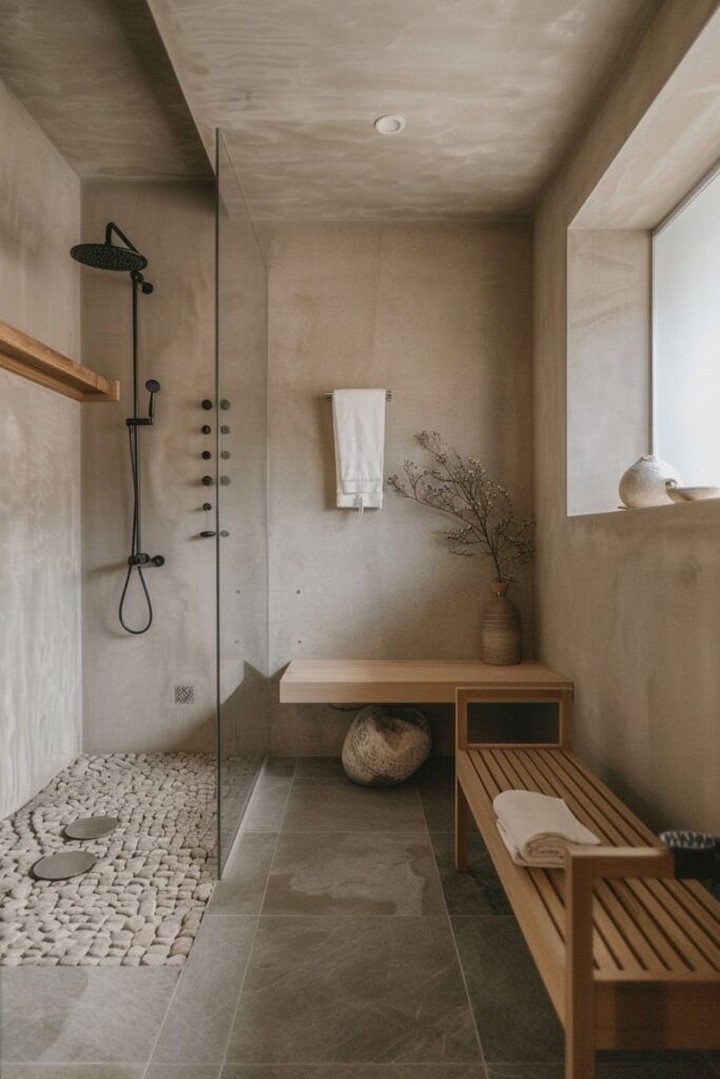
Replace plastic bath accessories with natural alternatives like sea sponges, wooden bath brushes, and plant fiber scrubbers. These functional items double as textural decorative elements when not in use.
Sustainable Approaches
46. Water-Saving Fixtures
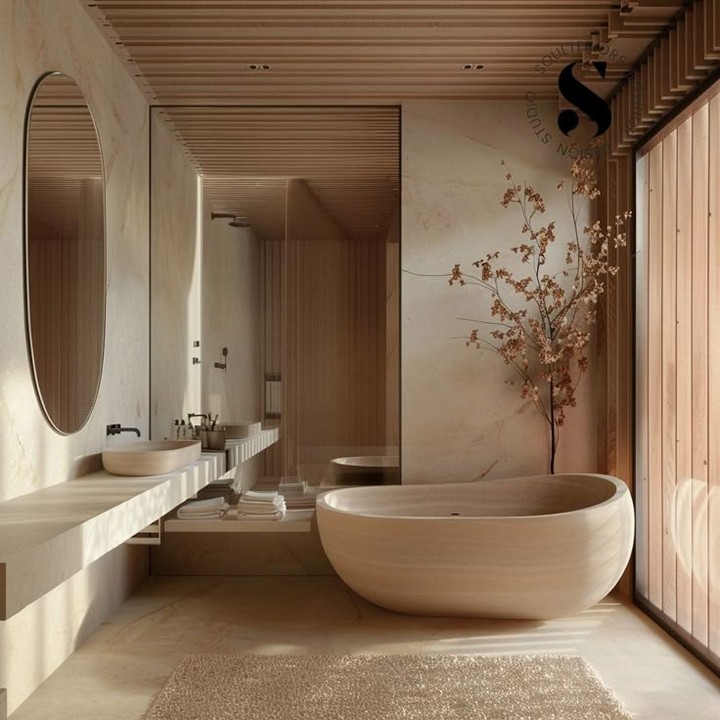
Align with the Japandi respect for natural resources by selecting water-conserving fixtures like low-flow faucets and dual-flush toilets. Choose models with minimal, clean-lined designs that maintain aesthetic coherence while reducing environmental impact.
47. Renewable Material Focus
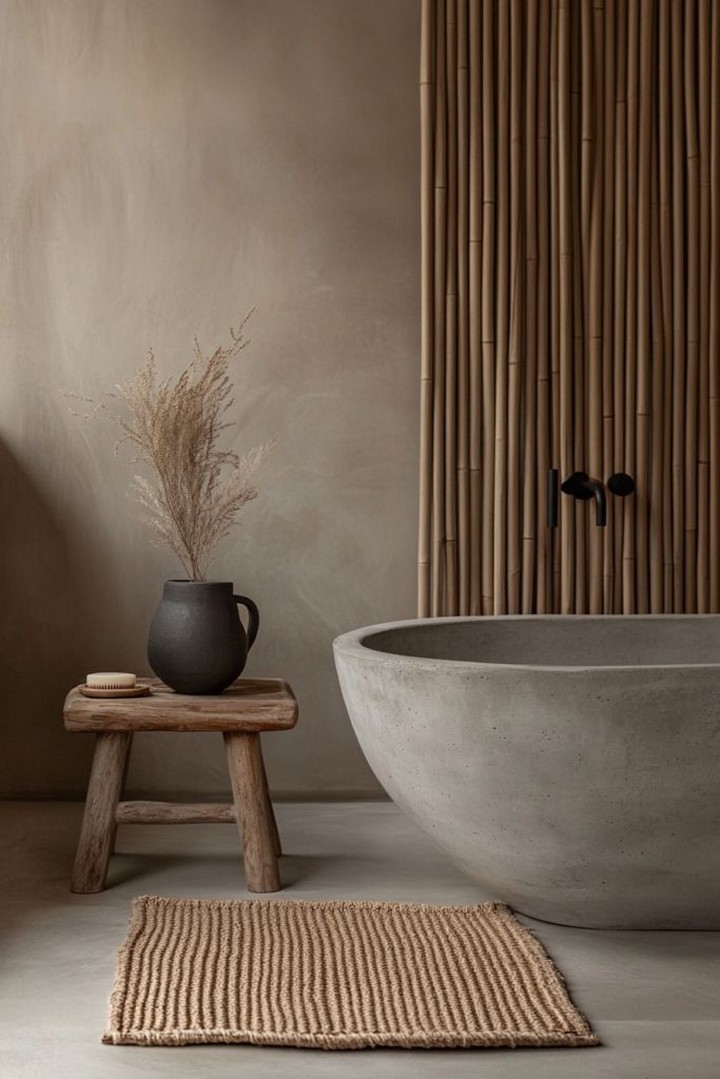
Prioritize rapidly renewable materials like bamboo flooring or reclaimed wood elements. These sustainable choices reflect the Japandi concern for environmental harmony while providing the natural aesthetic central to the style.
48. Indoor Plants for Air Purification
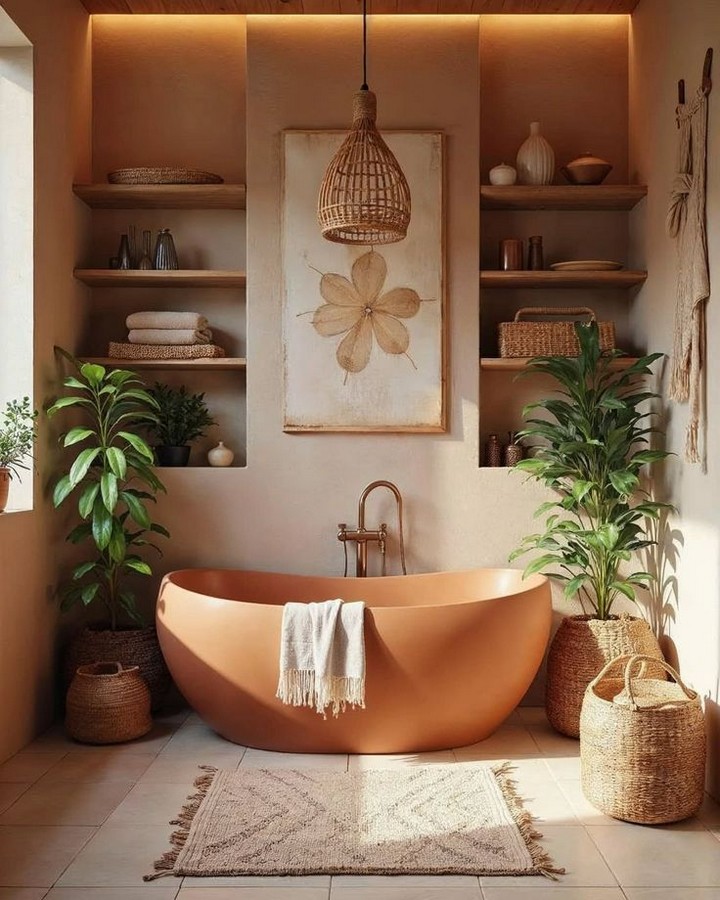
Incorporate plants that thrive in bathroom environments like ferns, peace lilies, or bamboo. Beyond their visual appeal, these living elements improve air quality and maintain connection to nature central themes in both Japanese and Scandinavian design traditions.
49. Natural Cleaning Solutions
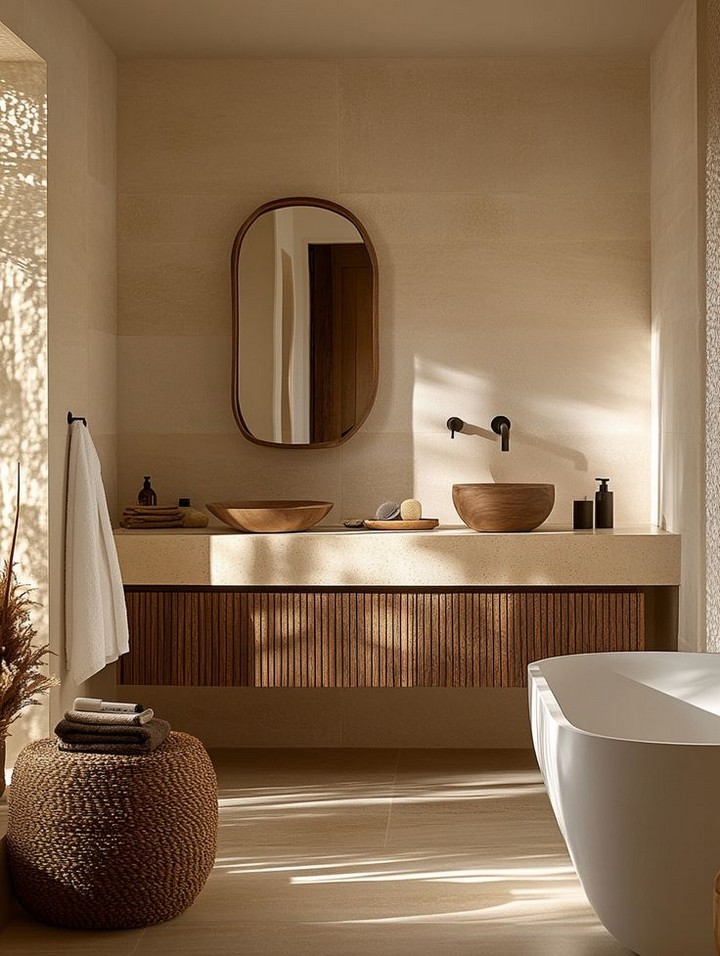
Maintain the Japandi bathroom with plant-based, minimally packaged cleaning products. This approach extends design coherence to maintenance routines while reducing chemical exposure and environmental impact.
50. Daylight-Responsive Design
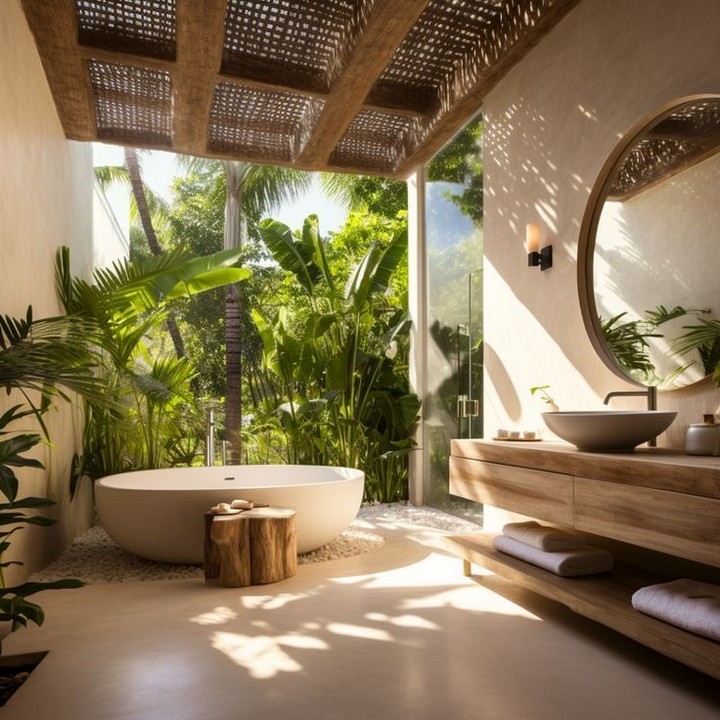
Design the bathroom layout to maximize natural light utilization throughout the day, reducing electricity needs. Consider how morning and evening light patterns affect the space, positioning elements to take advantage of natural illumination cycles.
Creating Your Japandi Bathroom: Practical Implementation
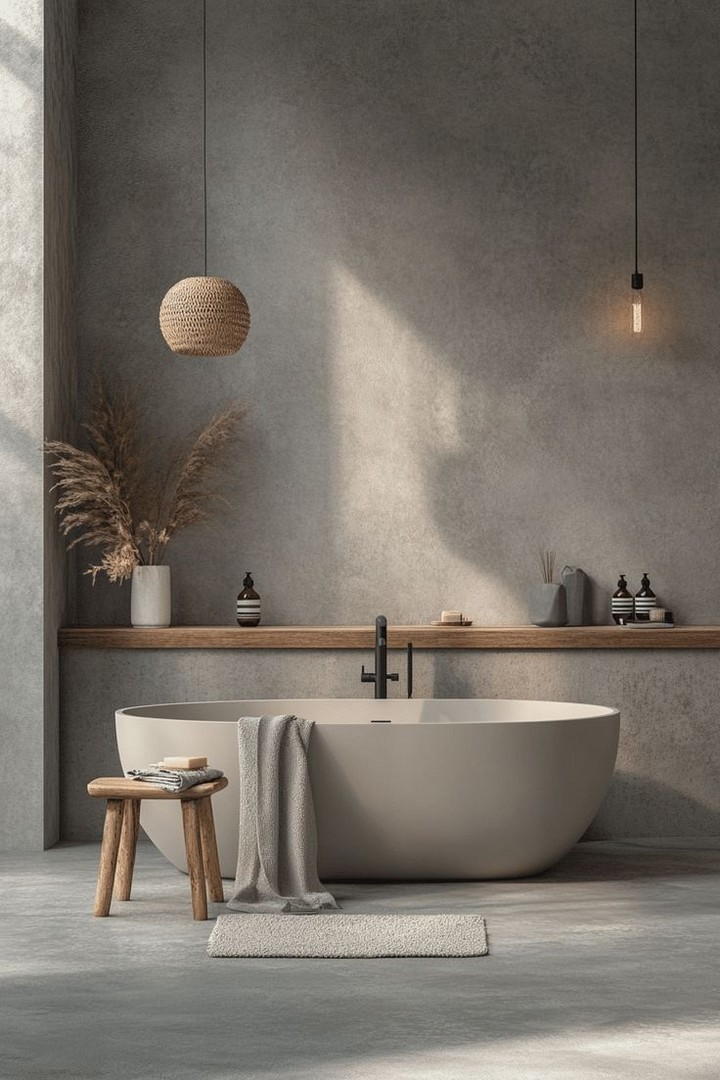
When implementing these Japandi bathroom ideas, consider these practical tips:
Start with Thoughtful Subtraction
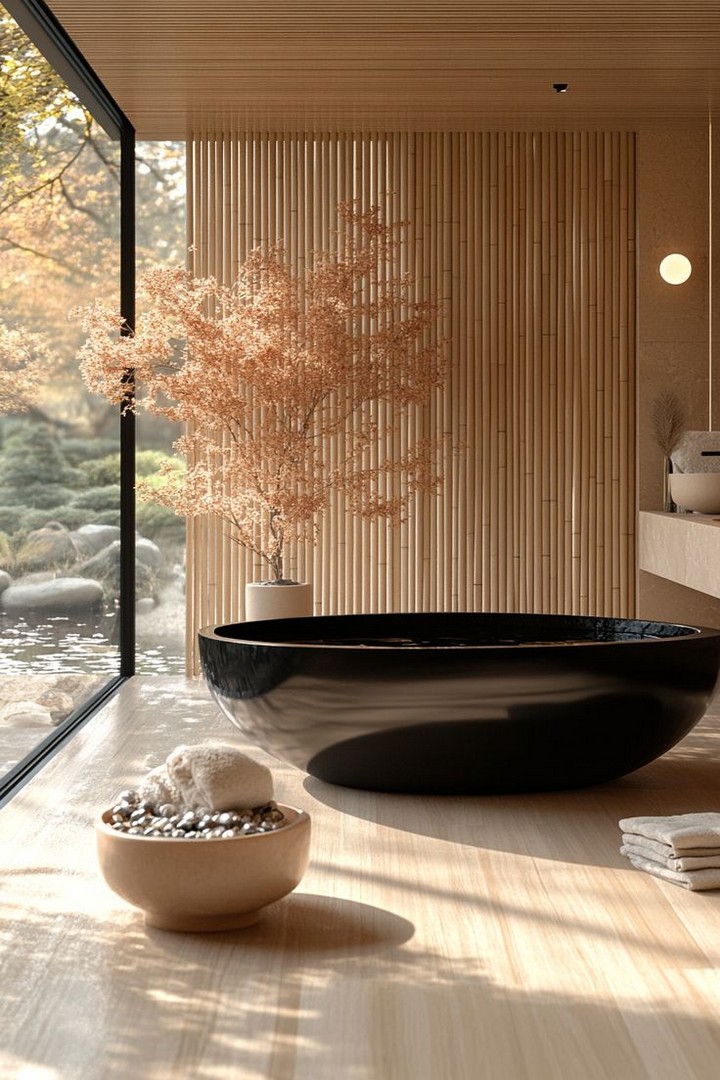
Before adding new elements, evaluate what can be removed from your current bathroom. Japandi design often begins with thoughtful elimination rather than addition.
Focus on Quality Over Quantity
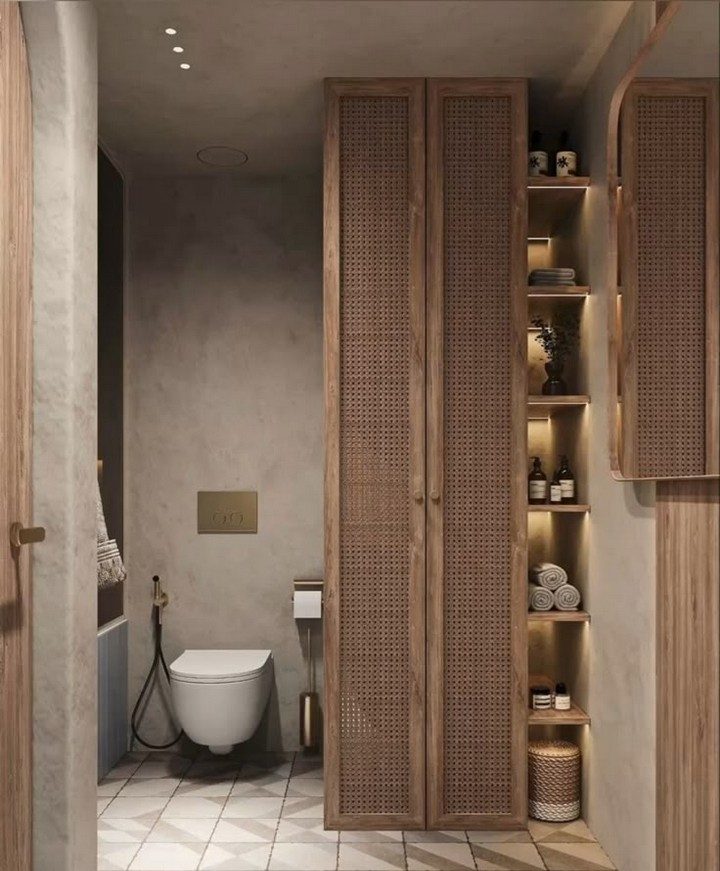
Invest in fewer, higher-quality pieces rather than numerous inexpensive items. This approach honors the craftsmanship central to both Japanese and Scandinavian traditions.
Consider Scale Carefully
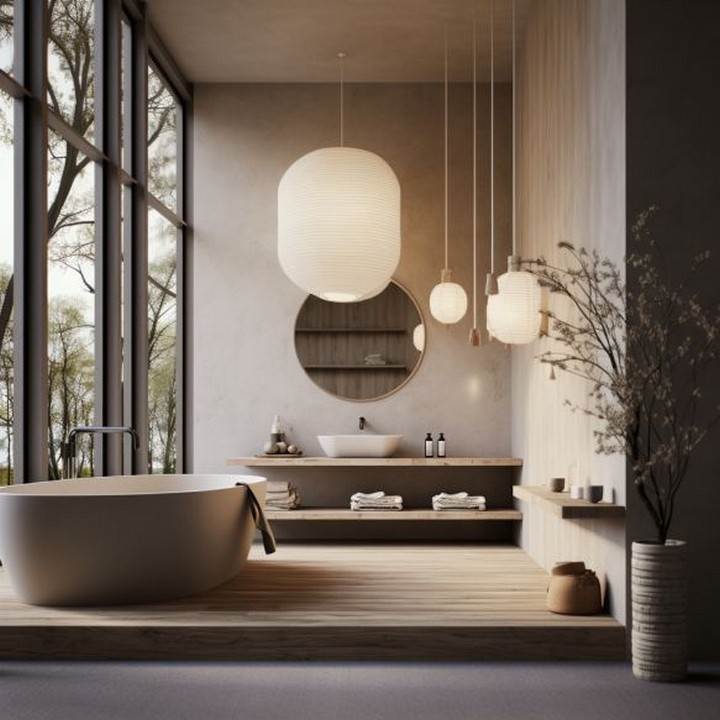
Ensure that fixtures and features are appropriately sized for your space. Oversized elements can overwhelm smaller bathrooms, while undersized features may feel insignificant in larger spaces.
Balance Warm and Cool Elements
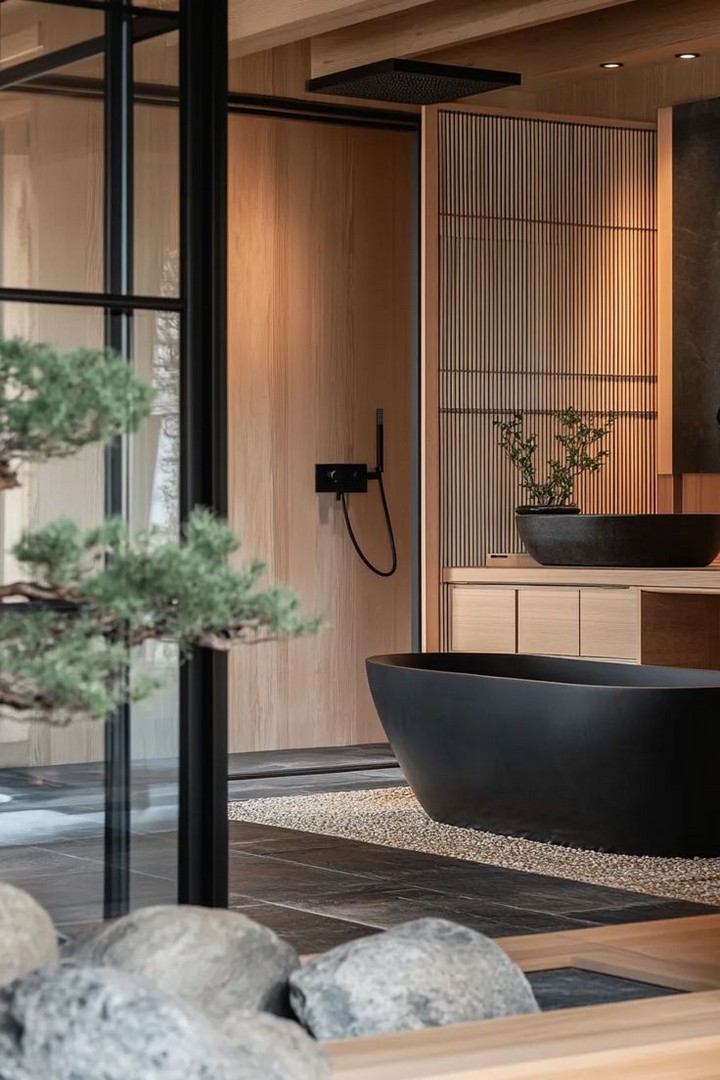
Create visual harmony by balancing warm elements (wood, terracotta) with cooler components (stone, concrete). This temperature contrast adds depth while maintaining overall cohesion.
Embrace Imperfection
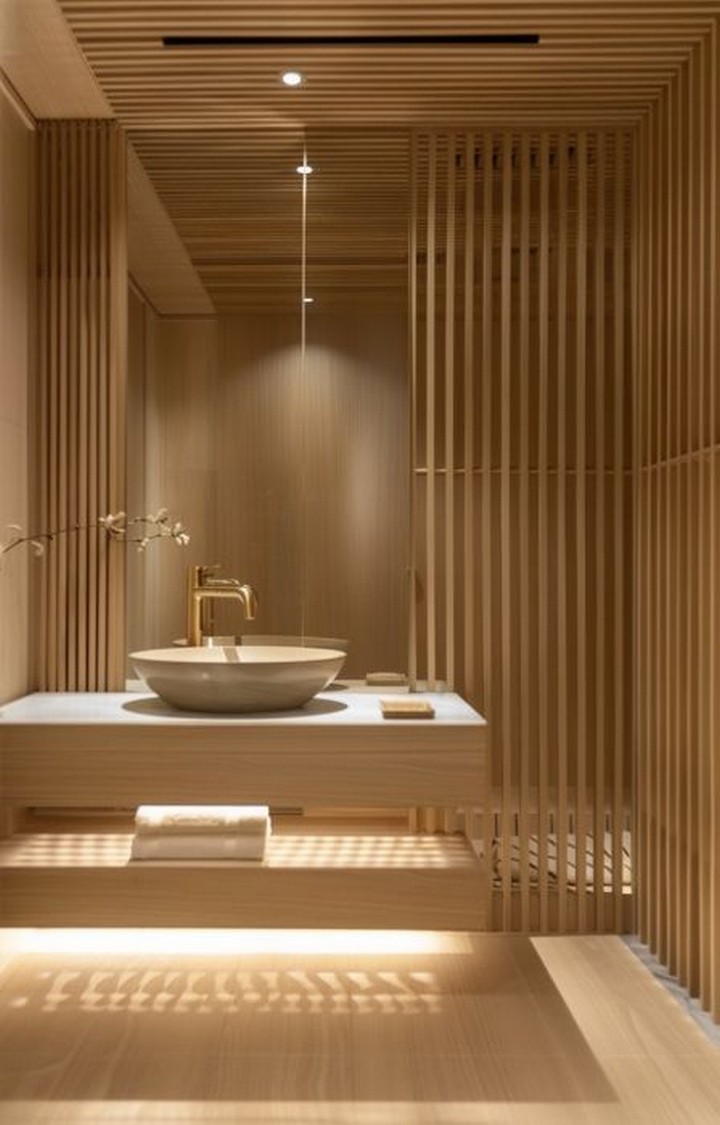
Remember that wabi-sabi the appreciation of imperfection is central to Japandi style. Handcrafted elements with subtle irregularities often bring more authentic character than perfectly uniform factory-made alternatives.
Timeless Tranquility

The Japandi bathroom represents more than just a design trend it embodies a thoughtful approach to creating spaces that support wellbeing through simplicity, natural beauty, and functional design. By incorporating elements from these 50 ideas, you can create a bathroom that serves not just as a utilitarian space but as a daily retreat that nurtures both body and spirit.
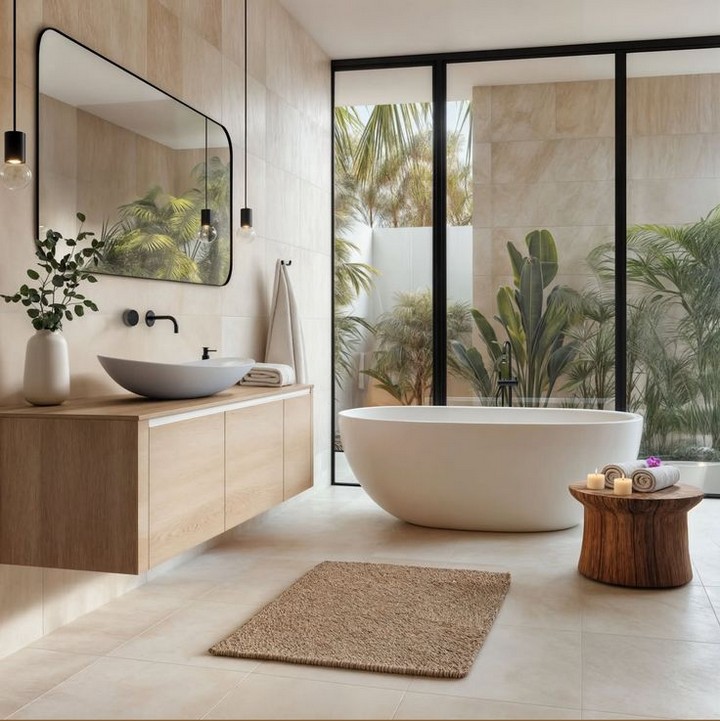
The beauty of Japandi design lies in its timelessness. While trends come and go, the fundamental principles of this hybrid style connection to nature, appreciation of craftsmanship, and mindful minimalism remain enduringly relevant. A well-executed Japandi bathroom will likely feel as fresh and appealing decades from now as it does today.
By thoughtfully applying these design principles and ideas, you create not just a beautiful bathroom but a sanctuary that encourages mindfulness and appreciation of simple pleasures a fitting antidote to our often hectic modern lives.
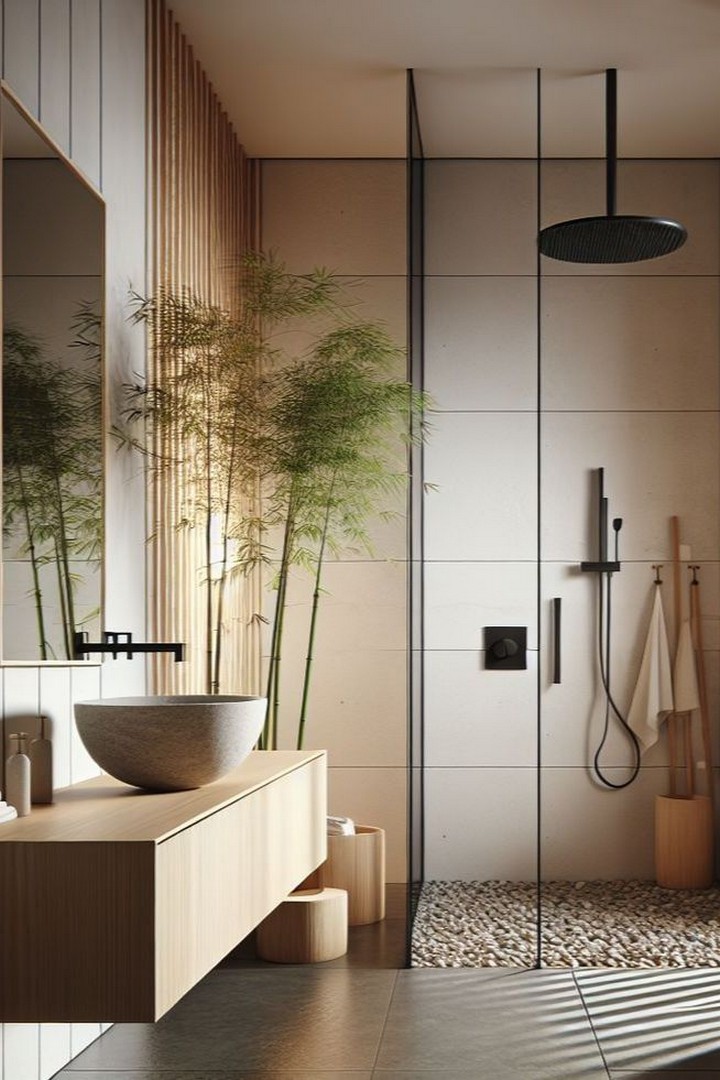
Have you incorporated Japandi elements in your bathroom renovation? We’d love to see your interpretation of this beautiful design philosophy! Share comments below or tag us on social media with #DecoMagz #JapandiBathroom.
Planning a bathroom redesign and have questions about implementing these Japandi ideas? Drop your questions in the comments section, and our design experts will provide personalized guidance to help you create your perfect harmony of Japanese minimalism and Scandinavian warmth.
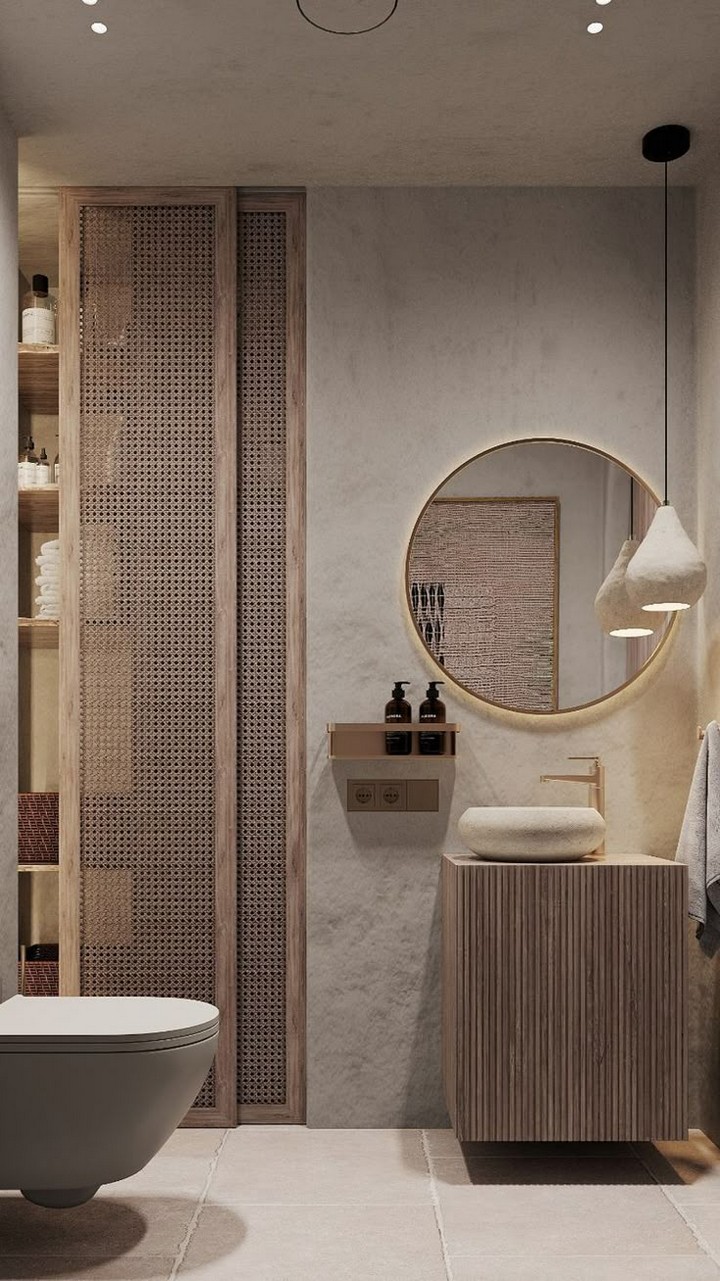
For more inspiration on creating serene spaces throughout your home, explore our related articles on Japandi living rooms, bedrooms, and kitchen designs!
Happy designing! 🛁✨

